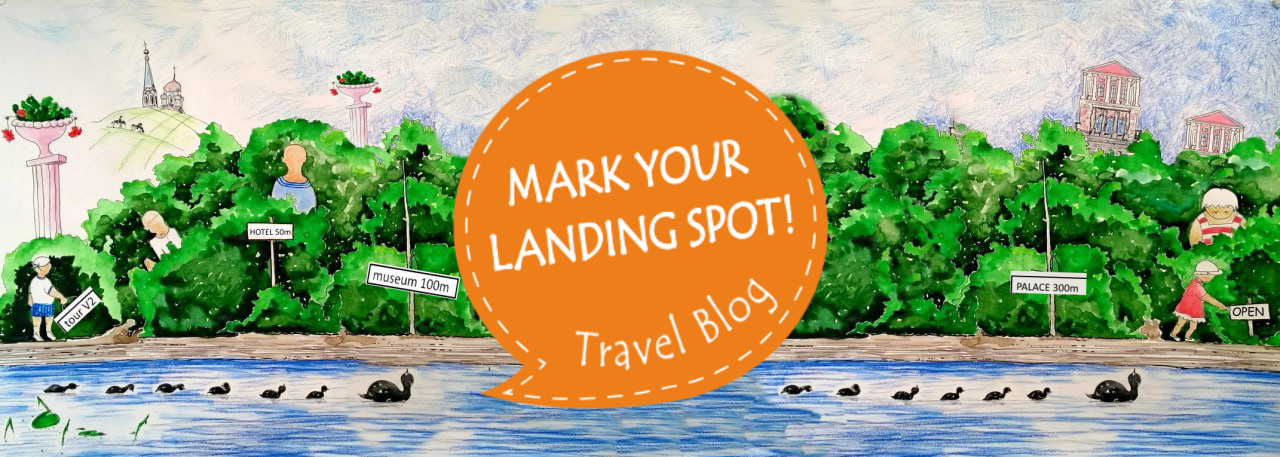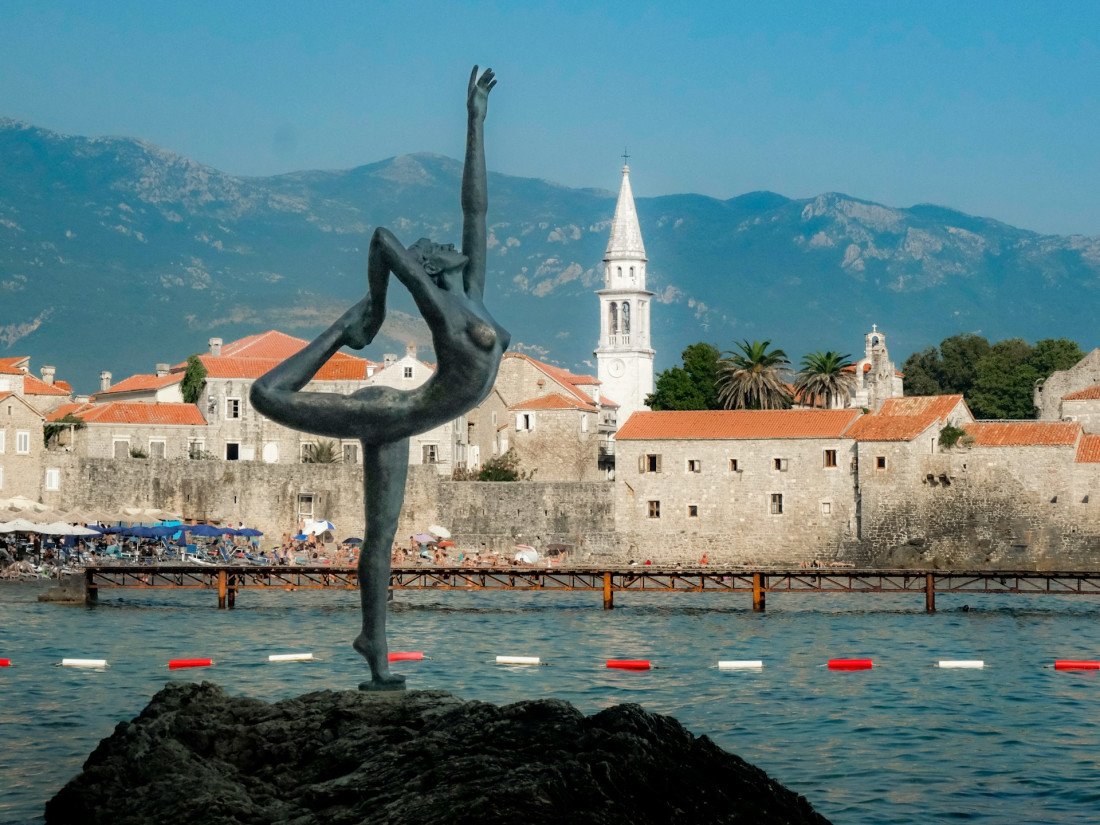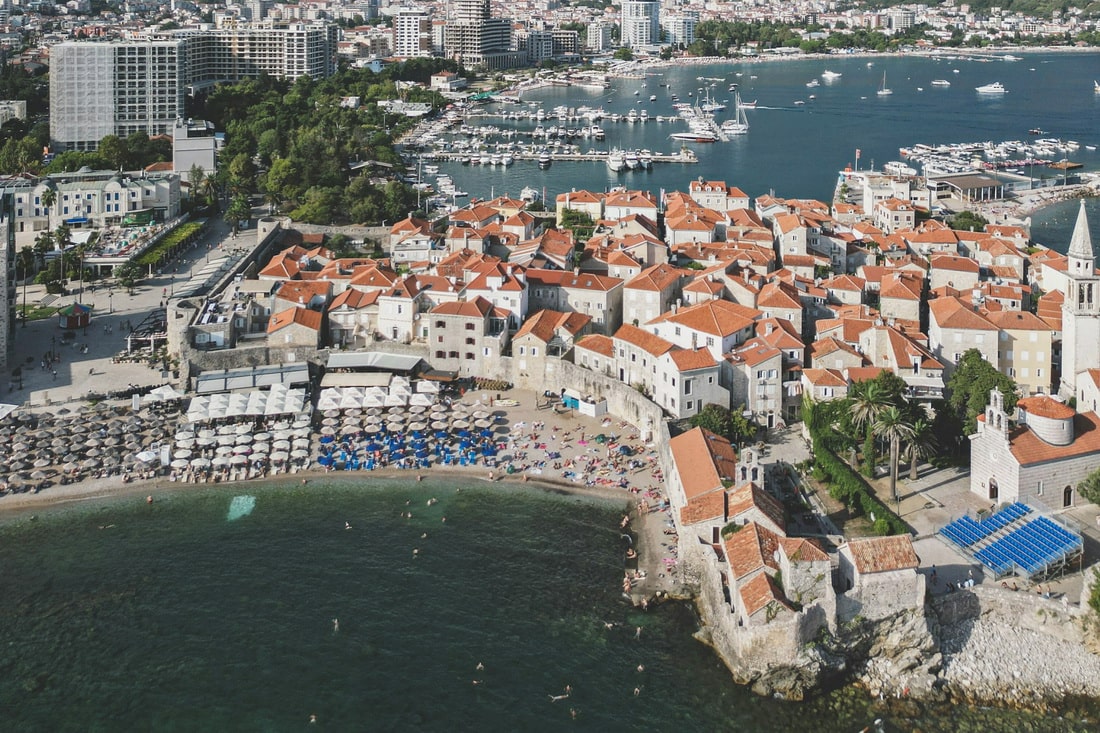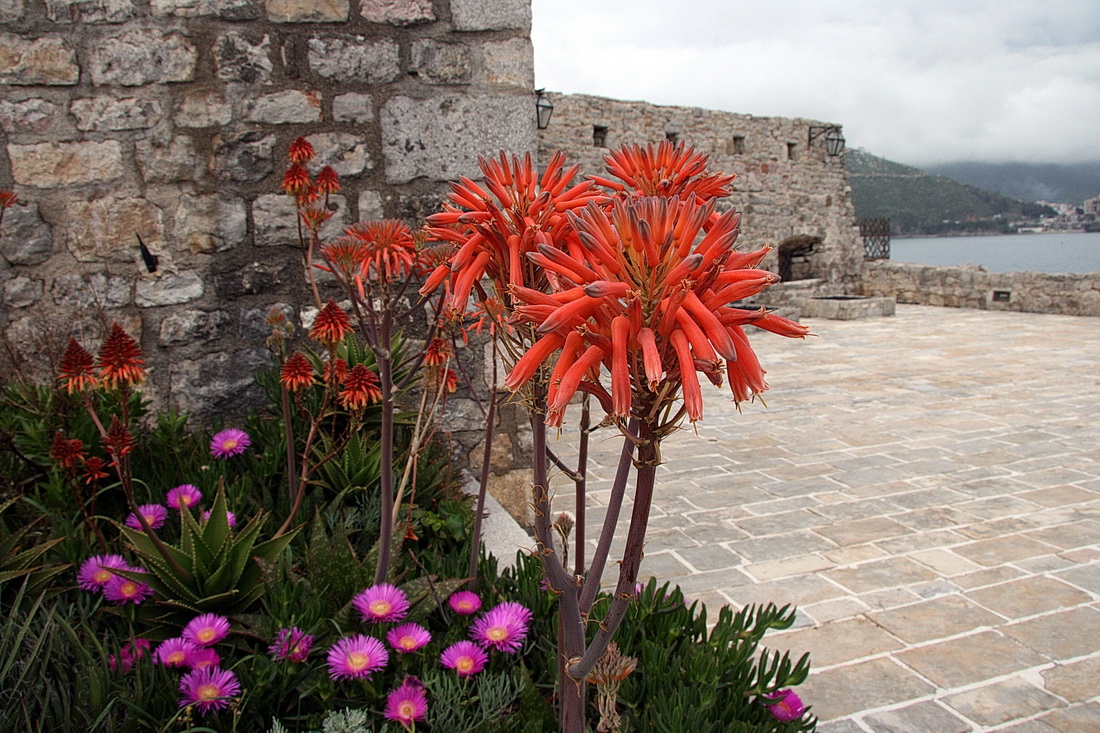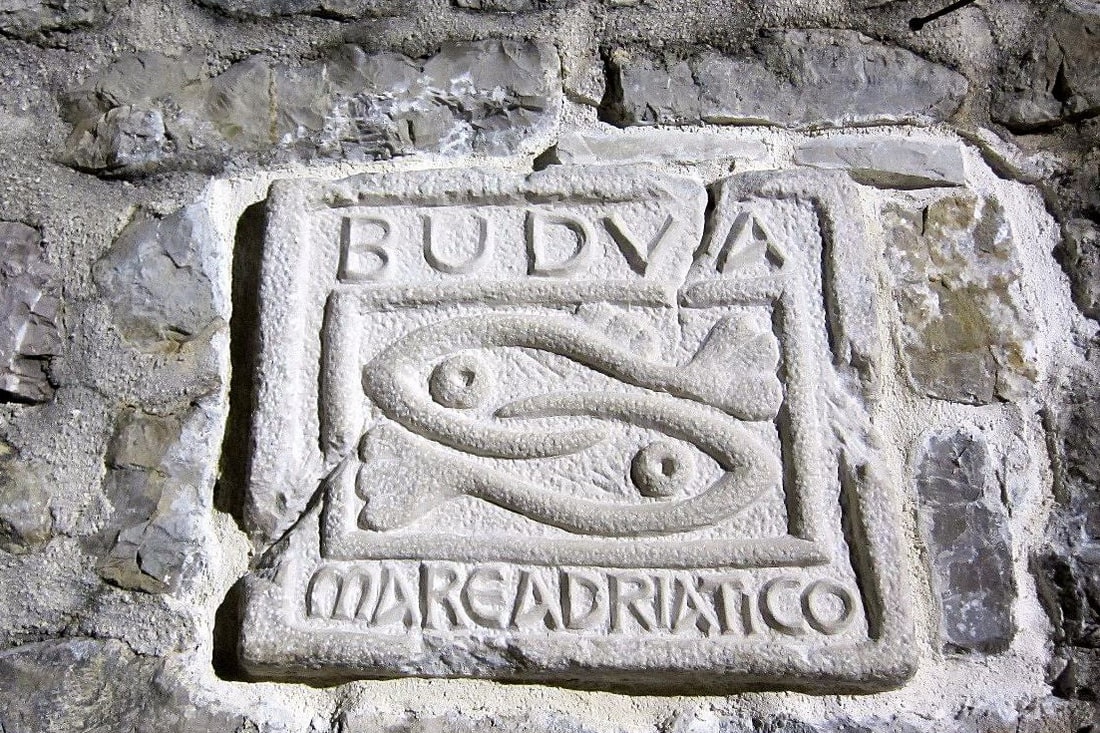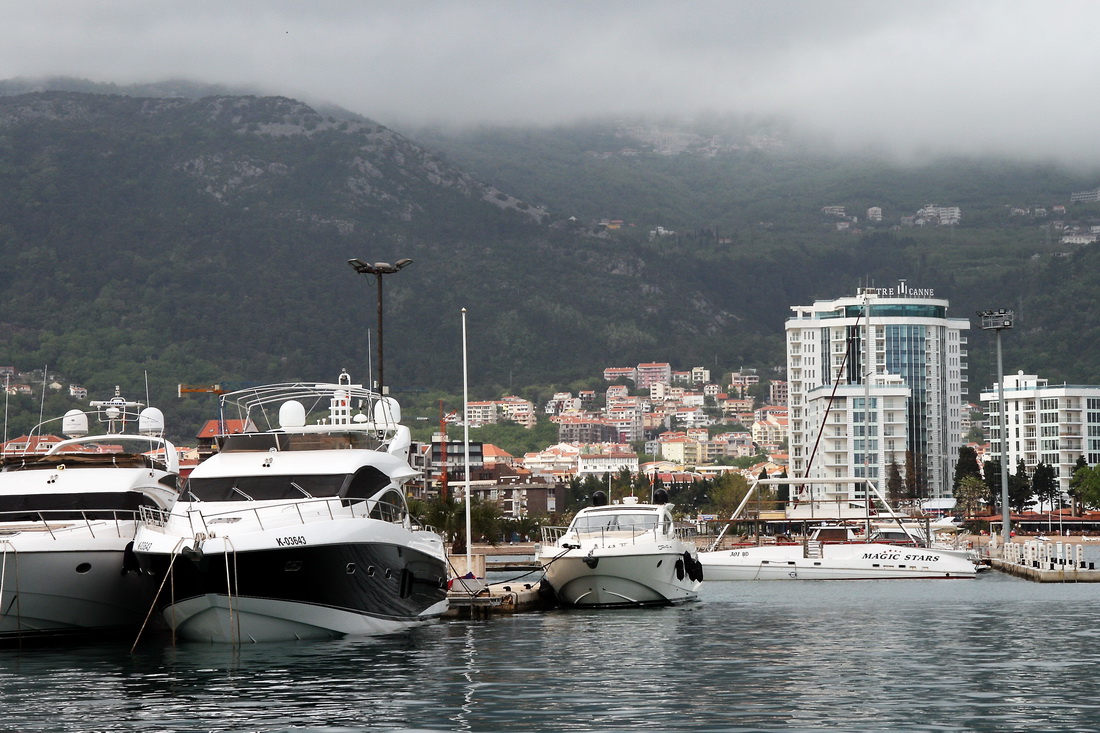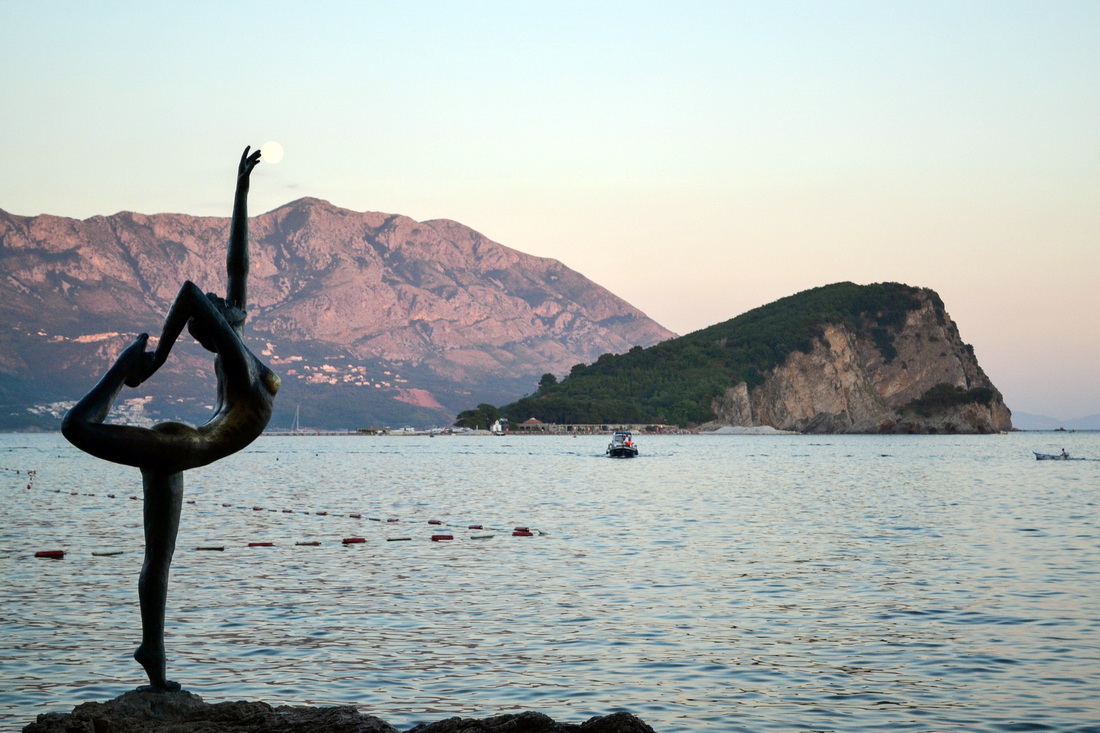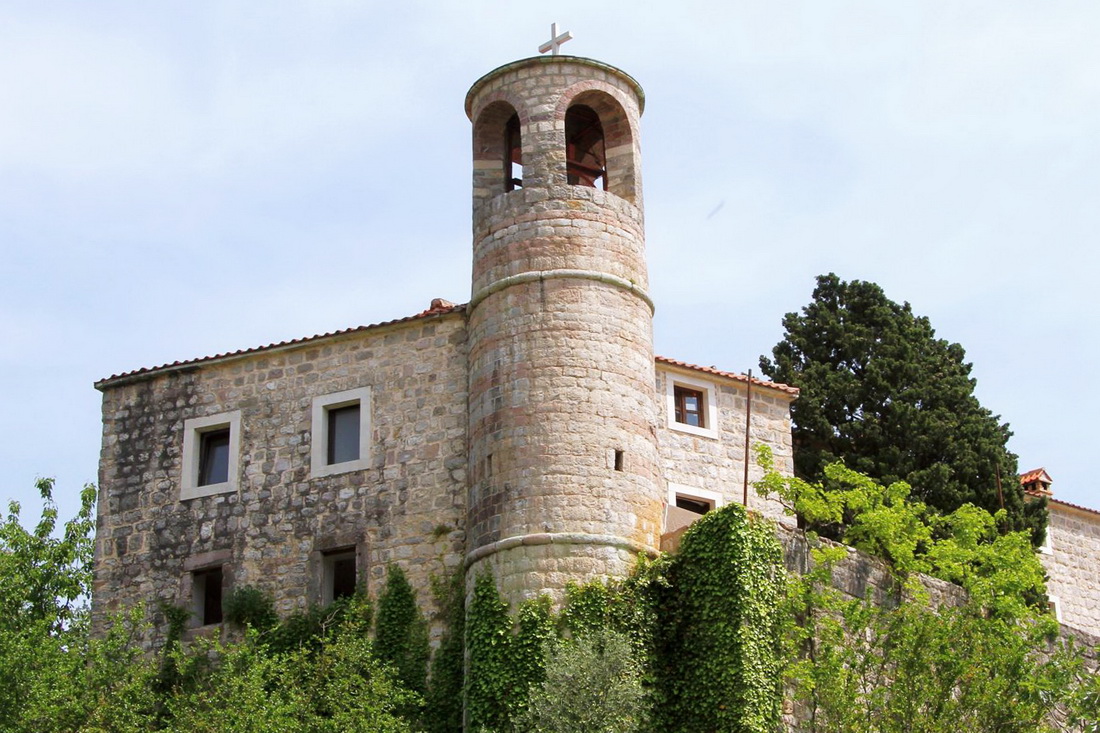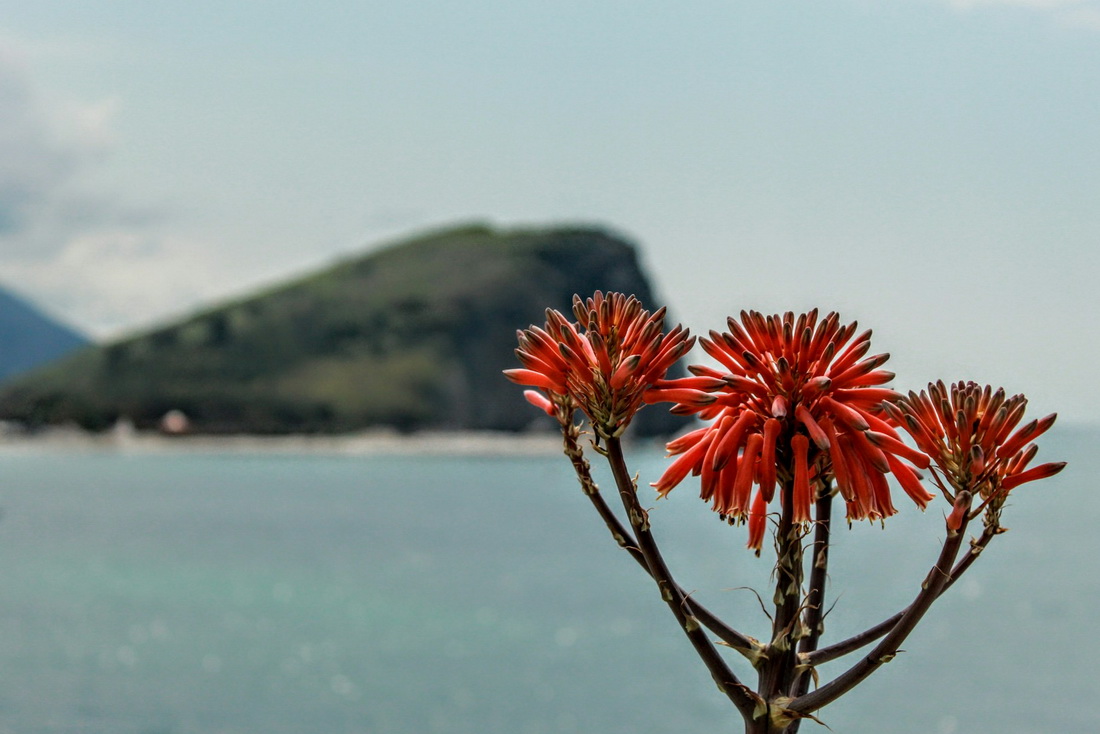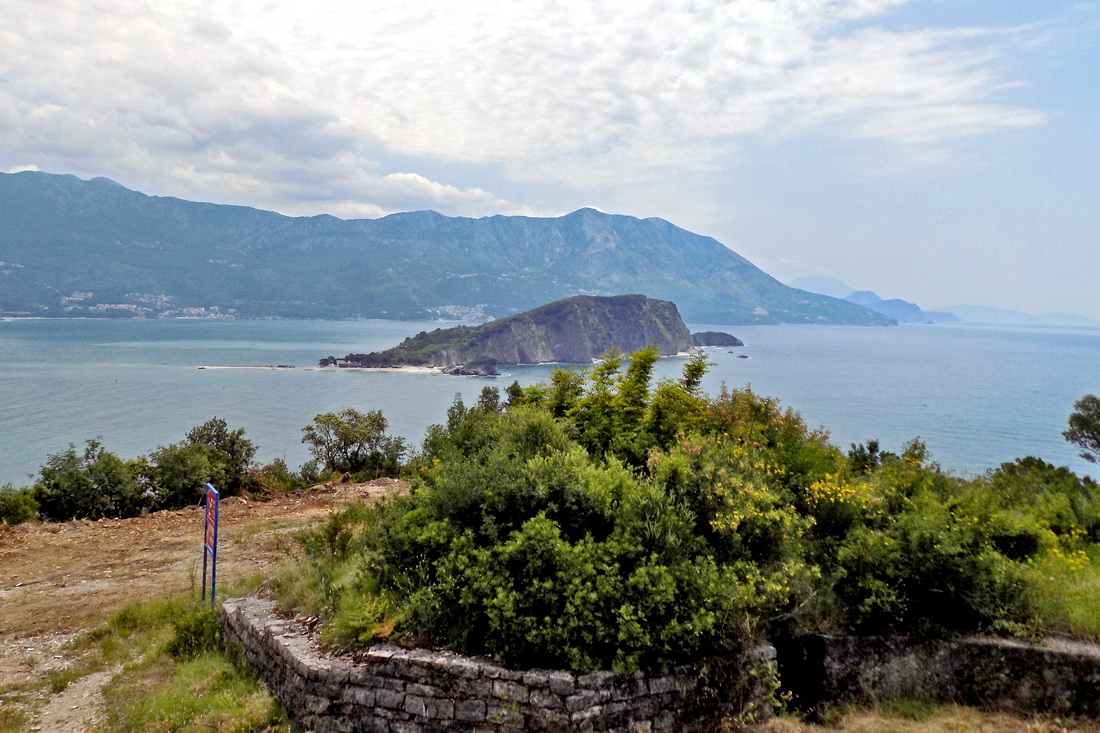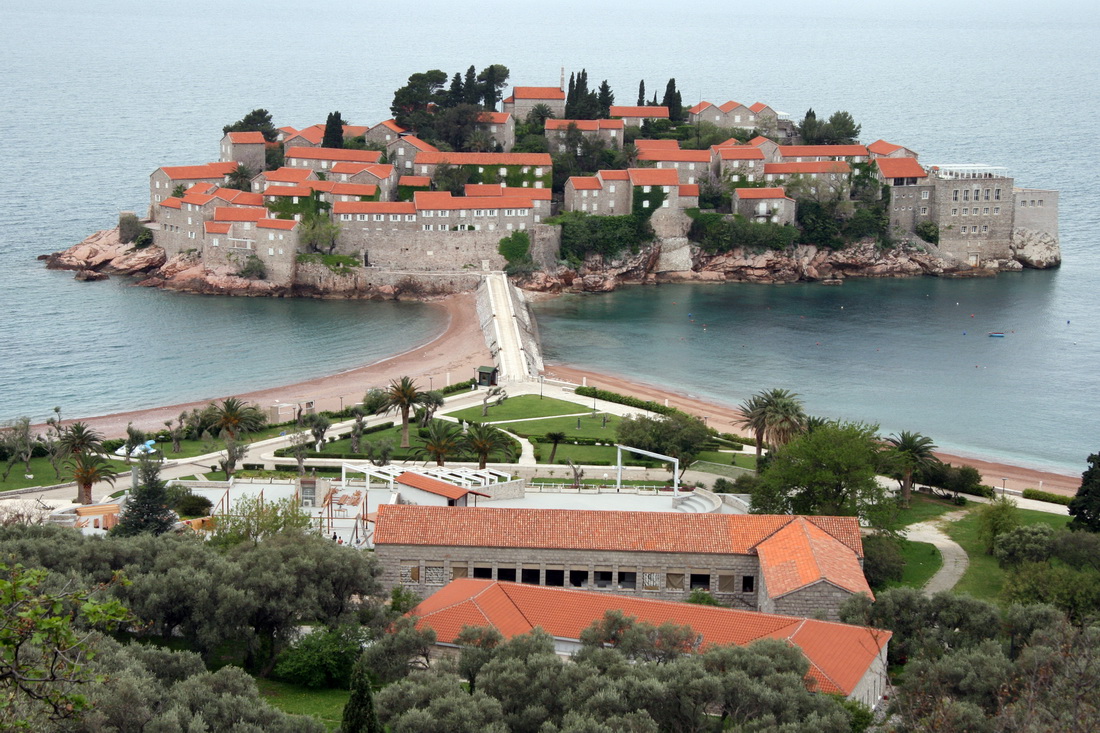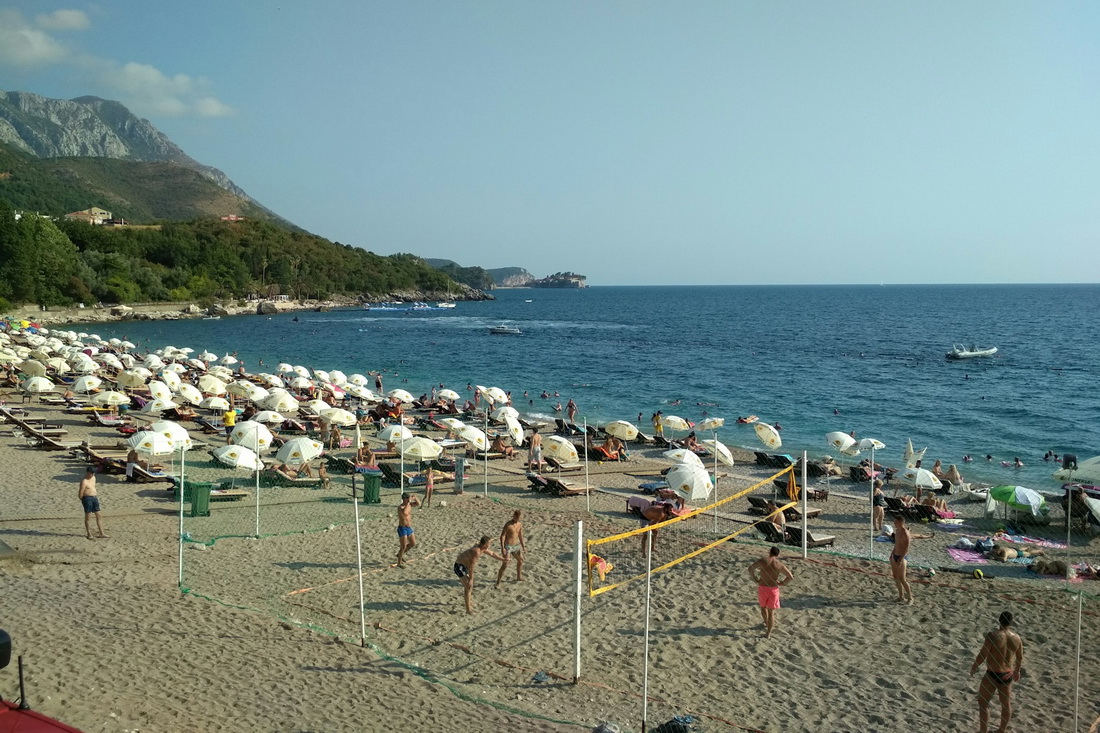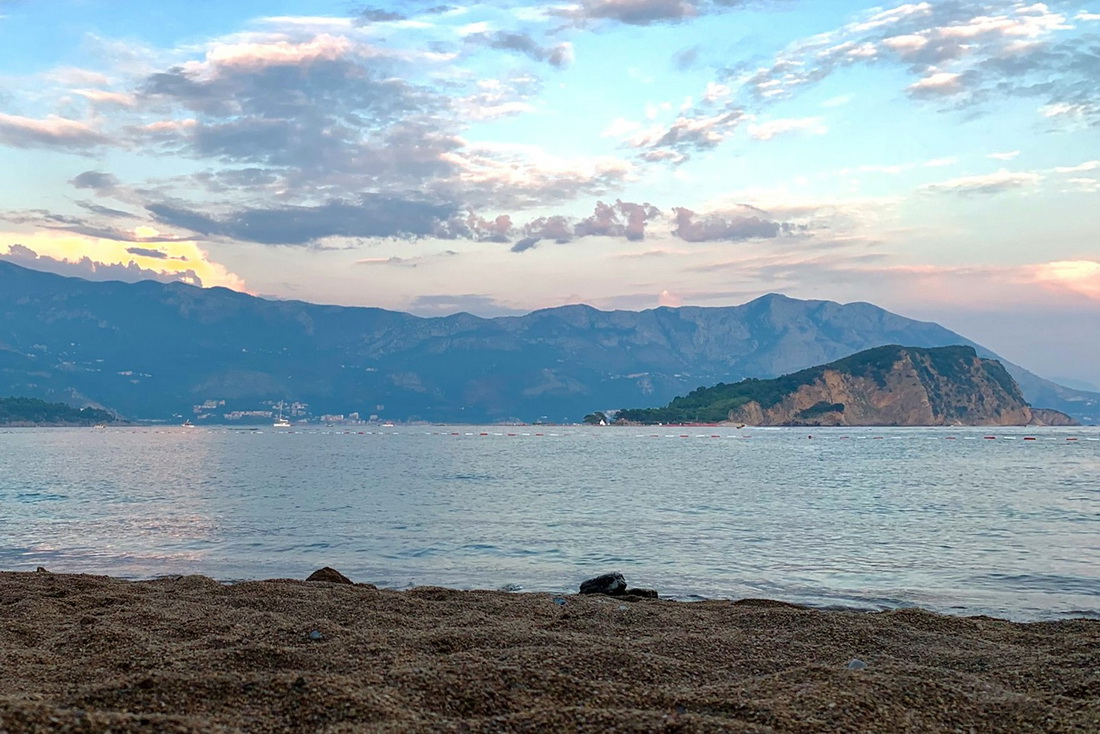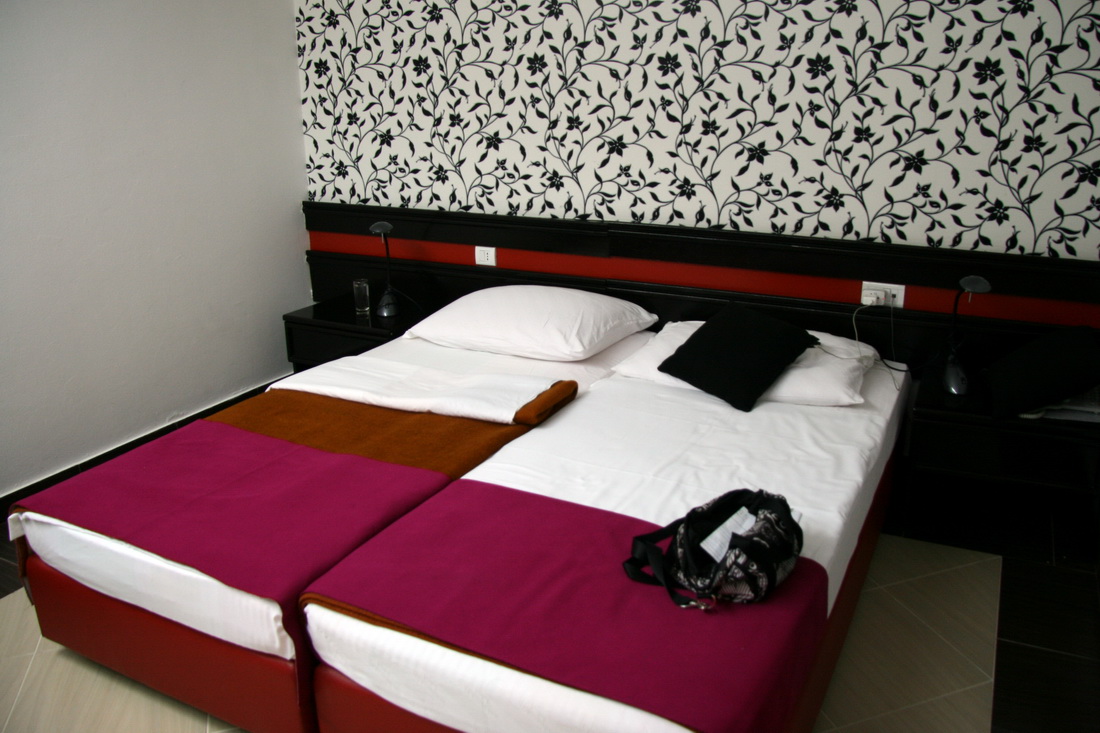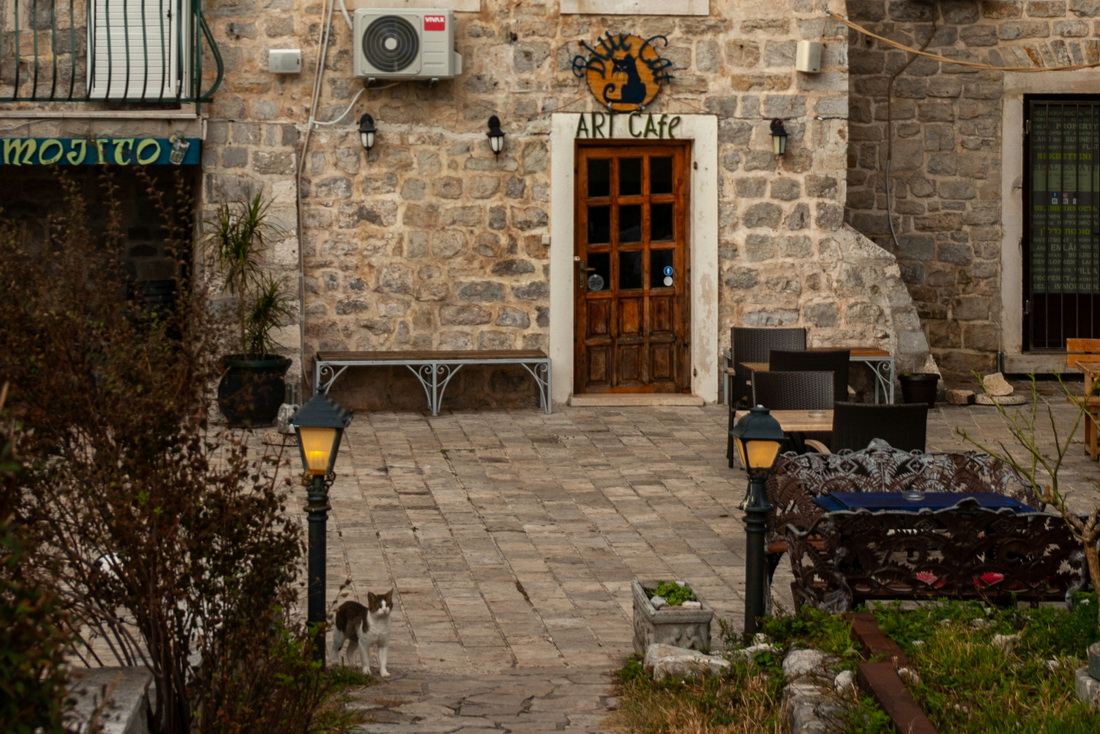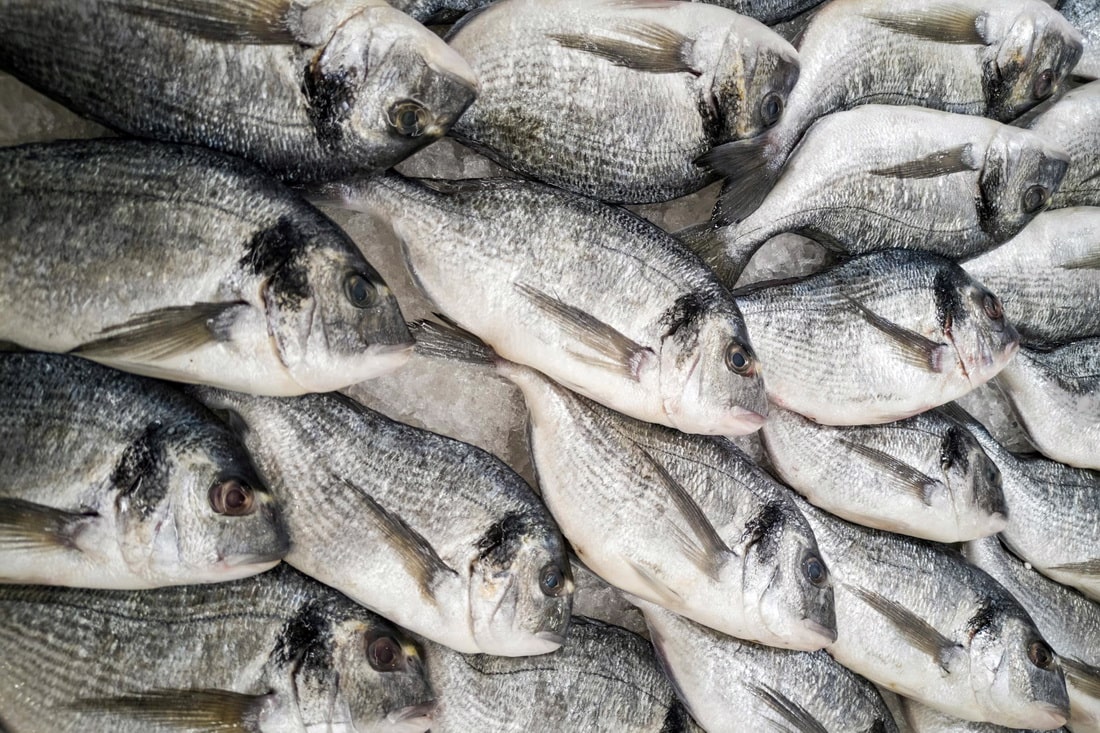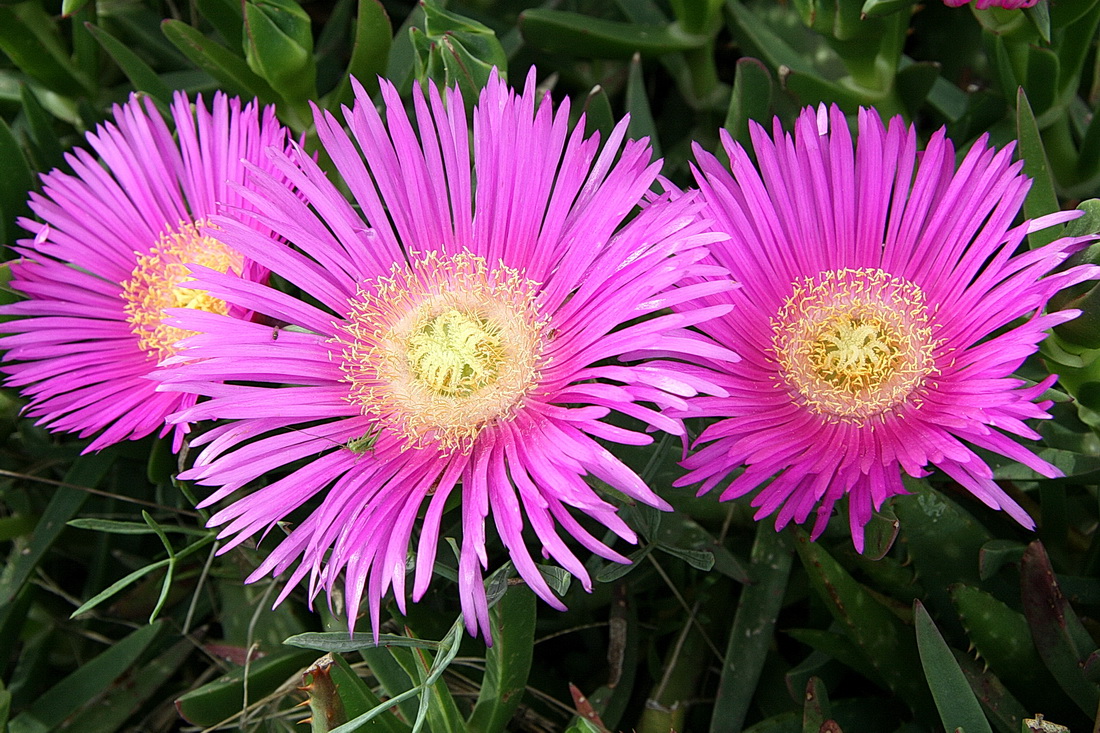In summer, Budva feels like half of Europe decided to meet on the same stretch of coast. In this guide to Budva you’ll see why: beaches overflow, restaurants buzz, and the nights last as long as the music.
For a town of about 17,500 people, Budva has a surprisingly big summer vibe. Some visitors come for a weekend, others for weeks—and most end up craving just one more swim.
Why Budva?
Because the sea sets the pace. You can swim before breakfast, wander stone lanes in the Old Town, and be on Sveti Nikola—the piney island opposite Budva—by lunchtime.The main beach buzzes, but a short walk finds quieter coves with fewer umbrellas and more water. Evenings mean grilled fish, local wine, and honey-gold walls at sunset.And as a base, Budva is hard to beat: Kotor and Perast are within easy reach, Sveti Stefan sits round the headland, and the Kotor–Lovćen cable car lifts you to a bay-wide view.
Why not? July–August can feel relentless—crowds, music that carries at night, and concrete where you’d prefer romance.
If you crave calm, aim for April–May or September, pick a quieter base (Bečići or Pržno), and treat Budva as your lively hub rather than your lullaby.
A quick reality check:
- Buses that arrive when they feel like it.
- Traffic that crawls just as you’re in a hurry.
- A waiter who disappears mid-order—and reappears with a smile.
But then—the Adriatic sparkles, the locals smile like old neighbours, and the view makes up for the wait. Somehow, it balances out.
Let’s get into the details.
What to see in Budva
With 2,500 years of history under its belt, Budva has seen just about everyone—Greeks, Romans, Byzantines, Venetians. These days, it’s mostly sun-seeking tourists and the occasional seagull, but traces of the past are still everywhere.
Budva Old Town is the obvious start: Venetian walls, narrow lanes, churches tucked into courtyards, and café tables spilling into tiny squares. Sunset makes the stone glow honey-gold, and even if you’ve looped the streets once, the light keeps changing the mood.
Step outside the walls and you’re in Budva New Town—less postcard, more pulse. Here it’s beach bars, bakeries, markets, apartment blocks, and nightlife that either keeps you dancing or makes you long for quieter Bečići.
Budva also makes a great base for day trips: Sveti Stefan, Tivat, Kotor—all just a short drive away. But don’t rush off too quickly. There’s more to Budva than beach towels and sunset cocktails.
The town puts on events, concerts, and open-air performances throughout the season. Even if you’re not chasing culture, you’ll likely stumble into something—a festival in the square, a DJ set on the beach, or a wedding party dancing through the streets.
If my photos look a bit grey, that’s just me avoiding the midday sun.
Coming from the north, I’m not built for 33 °C and blazing skies. But most days here are blue and bright, even if I tend to walk in the shade.
1. Old Town (Stari Grad)
Budva’s Old Town is tiny—so tiny, you could probably fit it into a wide-angle shot. But don’t let the size fool you. You could walk these streets every day and still find new corners, a quieter café, or a better gelato spot. And those sunset views from the citadel walls? Easily among the best in town.
Enclosed by thick Venetian walls, the old town is all stone alleys, church spires, and shuttered windows. It’s charming but lived-in, with street cats lounging under fig trees and laundry lines stretching above your head.
The area was heavily damaged in the 1979 earthquake but has since been carefully restored. Today, the historic houses host restaurants, boutiques, and tiny hotels with ivy climbing the walls.
In summer, the streets fill with music—sometimes from a solo violinist, sometimes from a full festival stage. There’s something going on almost every week, especially in the evening when the stone cools and the crowds come out.
Here are a few corners worth a closer look—tiny details that make the Old Town feel alive.
♦ Sveti Ivan
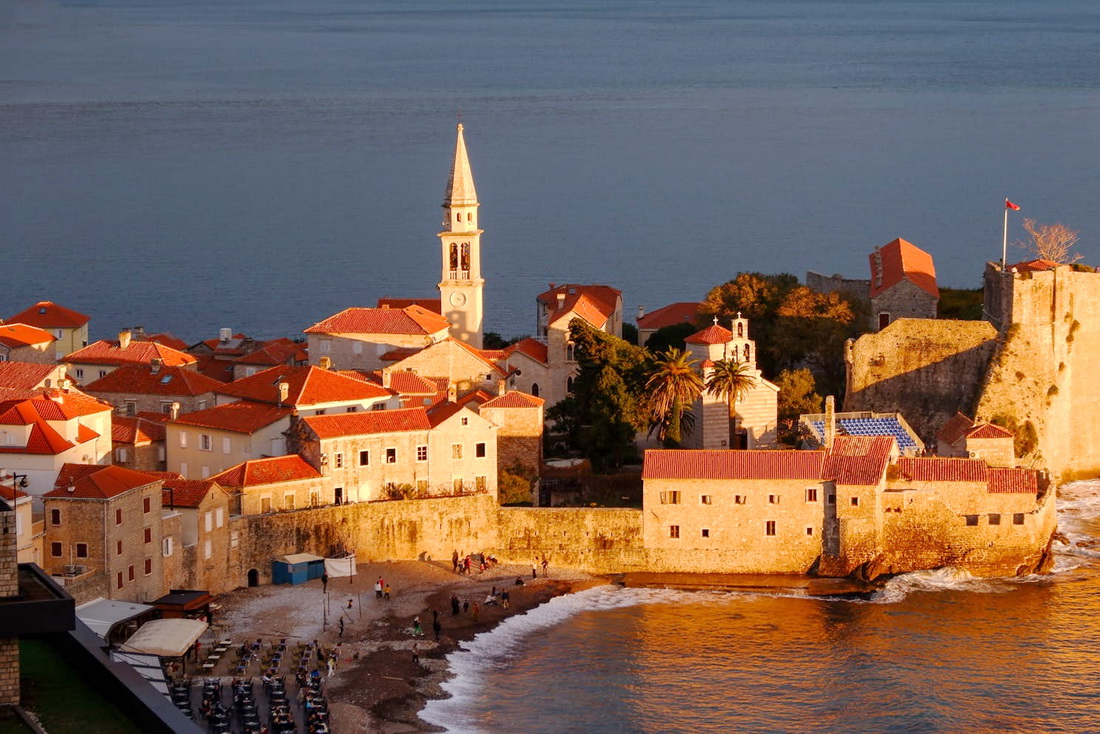
Not all churches in Budva are open, but Sveti Ivan usually is—step inside for cool stone, soft light, and a few peaceful minutes.
The Church of St. John—or Sveti Ivan, as it’s called locally—has been here in some form since the 7th century. It’s been rebuilt more than once, but it still feels timeless. From the outside, you’ll spot it instantly: the 36-metre bell tower rising above the old town is the most recognisable landmark in Budva.
Inside, the Catholic church is modest but serene. The altar wall features a distinctive mosaic-style design—unusual for this region. No entry fee, no fuss. Just walk in, sit down, breathe in the centuries.
How to enter respectfully: This is still an active place of worship—not just a sightseeing stop. Keep your shoulders covered, skip the swimwear, and move quietly if others are praying.
♦ Citadel
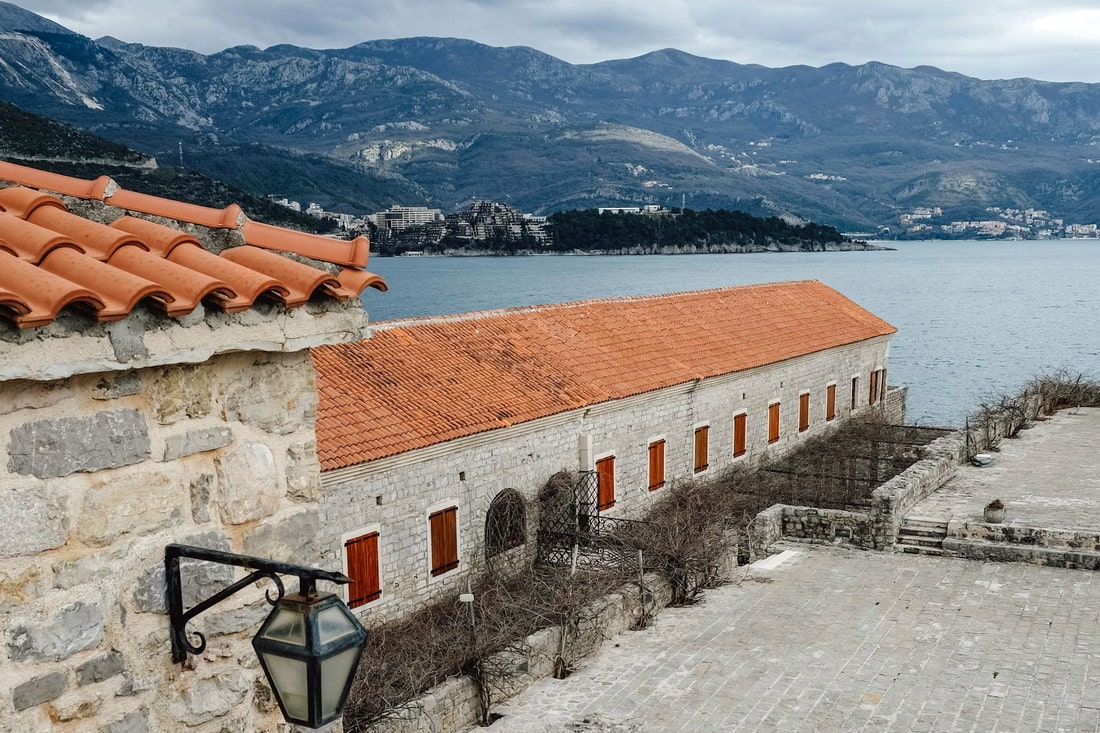
Visit the Citadel for sweeping sea views—and a look inside what was once the mightiest fortress on the Adriatic.
The Citadel (also known as the Fortress of Saint Mary) is a small walled fortress at the edge of the Old Town, perched above the sea, with towers, stone walkways, and lookout points once built for defence.
The Venetians constructed it in the 15th century, and it was once considered the most impregnable stronghold on the Adriatic—or so the local legends (and guidebooks) like to claim. These days, the only thing you’ll need to conquer it is a ticket—and maybe a hat.
Inside, there’s a small museum, a quiet little library with antique books under glass, and a panoramic terrace with views across the bay and over to Sveti Nikola Island. The golden hour hits just right up here—especially with a camera in one hand and a cold drink in the other.
The Citadel also houses a restaurant—Citadela Restaurant & Bar—with a sea-view terrace. It’s styled up (white tablecloths, wine list, dressed-up staff), but still very much a place that serves grilled squid to tourists in flip-flops. You’re here for the view, not a Michelin star.
It gets hot fast—the stone radiates heat and there’s little shade. So bring a hat, take some water, and don’t linger. Still, history buff or not, the view from the top is hard to beat.
If you go: Buy tickets at the gate; expect ~€5. Hours vary by season (roughly 09:00–20:00). The on-site restaurant doesn’t waive the entry fee—you’ll still need a ticket to enter.
♦ Fish relief
If you’ve already visited the Citadel, here’s a small detail you might’ve missed: a stone relief of two intertwined fish, quietly set into one of its inner walls.
According to local legend, the fish represent Budva’s own Romeo and Juliet: Elena, a girl from a wealthy family, and Marko, a humble stonemason. When her parents forbade the match (as they tend to do in these stories), the lovers leapt into the sea—and were transformed into fish, forever swimming together.
A voice from the sea was said to whisper, “Let two be as one” (Ko jedno nek budu dva). Some even link that to the origin of the name “Budva”—though no linguist would agree.
Whether or not you believe in sea-born love stories, there’s a tradition: if you touch the relief, your love will be as strong—and as durable—as stone.
Where to find it: Right before the passage that leads to the panoramic terrace, mounted low on the wall—about knee height. The stone is slightly darkened from years of hopeful hands.
♦ Budva city wall
For sea views without the full Citadel experience (or the restaurant pricing), try the Old Town wall. Built in the 9th century, it runs along the seafront and offers a quieter—and cheaper—lookout.
Don’t expect a grand loop like in Dubrovnik: here, the path ends abruptly, and you’ll have to double back the way you came. Still, the views are worth it, especially early in the morning or late in the day when the light softens and the stone isn’t boiling hot.
There are two access points: one near the Citadel and another close to the gate opposite the Avala Hotel, via the Mozart restaurant’s summer terrace—yes, really.
Expect to pay €2, or €3 in peak season. The walkway can close temporarily in strong winds or after storms—check the gate on arrival.
Watch your step: The path is narrow, with some uneven steps and low railings—not ideal if you dislike heights or have wobbly knees. Good shoes help.
2. Promenade
Right outside the Old Town gates begins the Budva seafront promenade—a lively, slightly chaotic stretch that curves along the waterfront and doubles as the town’s open-air lounge.
This is where Budva strolls, snacks, shops, and people-watches. You’ll pass cafés, souvenir stalls, sunhat sellers, beachwear racks, and lots of ice cream. It’s touristy but not without charm—especially in the evening, when the stone cools and the hills turn gold.
There are a few benches if you’re lucky, but don’t count on finding one at sunset. The busiest stretch is between the Old Town gate and the Avala Resort & Villas; for more breathing space, keep walking east toward Slovenska Beach.
Down by the water, fishing boats bob beside tour boats and a few humble yachts. No glossy glamour here—this isn’t Tivat—but the sea’s close and the breeze is real.
Boats leave from the small dock next to the Budva marina, just by the Citadel gate. Most offer quick round trips to Sveti Nikola Island (details below)—where you can swim, sunbathe, or grab a drink with your feet in the sand. Another popular option is the Sveti Stefan loop: you can’t land on the island, but the view from the water is lovely, especially at golden hour.
When to walk: The promenade gets packed from 18:00 onwards in summer. For a quieter vibe, come early in the morning—or wait until just after dark, when it cools down and the music starts.
3. The Dancing Girl Statue
Copenhagen has the Little Mermaid. Budva? The Dancing Girl statue—a bronze girl in mid-pose—arms raised, one leg lifted, balanced on a rock above the sea. Is she a ballerina? A gymnast? No one’s entirely sure, but she’s one of the most photographed sights in town.
The statue was made by sculptor Gradimir Aleksić and is tied to a local legend—one of love, waiting, and waves. As the story goes, a young dancer fell in love with a sailor. He left on a voyage and never returned. Still, she came to the same spot by the sea each day, dancing while she waited—until the end of her life.
You’ll find the statue about 200 metres from the Old Town, along the coastal path to Mogren Beach. It’s a lovely walk—rocky in places, with stunning views back toward the city walls. The girl stands alone on a boulder by the water, framed by cliffs and sea spray. Expect at least three people attempting her pose—some more gracefully than others.
Best light: Late afternoon, when the sun dips low and the cliffs glow warm behind her. Early morning is quieter—but the statue will likely be in shadow.
4. Podmaine Monastery (Podostrog)
If you’d like a calm escape from the bustle, Podmaine Monastery, also known as Podostrog, is a tranquil stop about 2 km north of the Old Town—an easy uphill walk through quiet residential streets. It’s a well-known local landmark, but you’ll still want to use a map — the path winds through quiet residential streets and isn’t always clearly marked.
The monastery dates back to the 15th century and once served as the residence of Montenegrin rulers. Inside the stone walls are two small Orthodox churches—one medieval, the other from the 18th century—and a garden filled with cypress trees, rosemary, and the sound of birds instead of scooters.
It’s an active monastery, not a museum. If the gate is open, you’re welcome to step inside—just move slowly and quietly. Sometimes a monk might greet you or offer a few words about the place. The view over Budva Bay from up here is beautiful in late afternoon, when the town glows and the sea softens.
Respectful dress: This is a working monastery. Shoulders and knees should be covered—a scarf or long skirt is fine.
5. Sveti Nikola Island
You’ll spot Sveti Nikola Island from anywhere in Budva—a long pine-covered island just offshore. It looks wild, but in reality, it’s a popular summer hangout with sunbeds, beach bars, and a restaurant.
Boats leave every 20–30 minutes from the marina near the Old Town (around €5–7 return in season). Just walk up to the kiosks by the promenade—no booking needed. For a private tour or custom route, Sea Tours Budva offers skipper-led boat at the marina.
You’ll be dropped at Hawaii Beach, the main landing spot. The island has several other small beaches too—some are only reachable by boat—and there’s no full circular trail; much of the interior is fenced or left wild.
The beach is rocky, so bring water shoes—especially if you wander off the main area. Sunbeds with umbrellas cost €15–20, or you can claim a patch of stone with your towel.
There’s food and drink, but the atmosphere is beach-clubby and the menu standard. You can preview the setup on the official Facebook page of Hawaii Beach Bar. Most people come for a swim, a few photos, and a couple of hours away from the mainland—and for that, it does the job.
It gets busy by midday, with DJs, cocktails, and a younger crowd. Not the quietest place, but if you’re after a swim and a change of scene, it’s a fun and easy escape.
Want peace? Come early: The first boats leave around 09:00—come early for shade and a bit of calm before the buzz kicks in.
6. Zelena Pijaca
This isn’t some romantic farmers’ market with wicker baskets and wildflowers—but it’s the real Budva, before the yachts and beach bars took over.
Zelena Pijaca (Budva green market) is a slightly scruffy collection of indoor stalls under a concrete roof. The building itself is worth a glance too: a low-slung modernist hall from Yugoslav times, with a rough charm and no frills.
If you’re after something edible to take home, this is where to look: pršut wrapped in paper, slabs of cheese from the north, honey in all shades of gold, and homemade rakija or blackberry wine in reused Coke bottles—Montenegro-style.
Don’t expect bargain prices—Budva is still Budva — but you can often taste before you buy. Some vendors are chatty, others silently hand over a toothpick. Either way, you’ll leave with something salty, strong, or sweet.
How to find it: The market is just a few minutes inland from the promenade—head past the post office and follow the scent of cheese and grilled bread. The entrance is on Mediteranska Street, near Slovenska Plaža and Mega Market.
Day trips from Budva
Budva keeps you busy on its own—beaches, bars, old walls. But if you’ve got a spare day (or just need a break from the crowds), the coast around it is packed with easy escapes
Kotor
Just half an hour away, Kotor feels like a world apart: walls zigzagging into the mountains, church bells echoing across the bay, cats stretched out on warm stones. Climb the fortifications if you’re feeling brave (and it’s not 33 °C in the shade), or just linger in a hidden square with a coffee.
Extra lift: from the Dub station just outside town, a new cable car glides to Mount Kuk in eleven minutes — suddenly the whole bay is below you, like a blue-and-green puzzle.
Perast (with Our Lady of the Rocks)
Tiny, baroque, and straight out of a painting. The facades seem to float on the bay, and boats shuttle you to the church-islet for that perfect postcard shot. Many guides pair Perast with Kotor in a single day—but I’d linger. The town deserves slow hours, a sunset glass of wine, maybe even a night on the waterfront.
Tivat
Budva’s polished little cousin. Porto Montenegro gleams with superyachts and boardwalk cafés where spritzes cost as much as dinner elsewhere. But two streets inland it turns Balkan again: corner bakeries, market chatter, laundry above your head. It’s a good place to slow down, grab lunch by the water, and stroll back along the marina when the sun sinks low.
Sveti Stefan & Miločer Park
That postcard islet on a causeway—closed to visitors, but still magnetic. The surrounding park is all pines, stone paths, and benches with front-row sea views. Queen’s Beach is open to the public again this season; rules can shift, so check the signs, but the walk through Miločer in late afternoon light is reward enough.
Petrovac
Less showy, more neighbourly. A promenade lined with gelato stalls, fishing boats bobbing in the small harbour, and a path curling around to Lučice beach. It’s where Montenegrins holiday with kids, where grilled fish comes with rakija and nobody cares what time it is.
Best walks and hikes around Budva
Budva may be better known for beach bars than boots—but it’s actually a great base for coastal hikes. No need to rent a car or plan a day trip: two of the best walking routes begin right in town.
If you’re here for more than just the beach, this Budva travel guide will point you toward the town’s best sea-view paths and crumbling fortresses—perfect for sweaty climbs and smug sunsets
1. Budva – Mogren Fortress, 3 km
This short but steep walk leads to the ruined Mogren Fortress above Mogren-2 Beach. Built by the Austro-Hungarians in 1869, it once guarded the coast—now it’s overgrown, abandoned, and completely unguarded.
There’s no entry fee, no fences, and usually no other people. What you get in return: a crumbling monument, quiet surroundings, and a brilliant view of Budva and Sveti Nikola Island.
The quickest way up is a steep footpath from Mogren Beach. For a gentler ascent, follow the road uphill from town—about 3 km one way. It’s a good morning workout, with a reward at the top.
2. Budva—Bečići—Rafailovići—Kamenovo—Sveti Stefan, 9 km

The thick arrow marks Budva, the small one—Sveti Stefan. Everything in between makes for one very scenic walk..
This is one of the best walks on the Montenegrin coast—scenic, accessible, and full of little discoveries along the way. It takes about 3 hours one way, mostly along flat seaside paths, and rewards you with postcard views, shady parks, and maybe a plate of grilled octopus.
Start in Budva and follow the wide promenade through Bečići—a built-up resort area with big hotels and a long, sandy beach. Then comes Rafailovići, where the seaside path tightens and the atmosphere shifts. Small boats bob in the harbour, and the promenade is lined with cafés and seafood restaurants. It’s a good spot to pause for a coffee or lunch.
From Kamenovo Beach, the real walk begins. The paved path disappears, replaced by a narrow forest trail and a short tunnel carved into the rock. Then comes the least pleasant bit: about 750–800 metres walking along the main road, without a proper pavement. It’s safe but noisy, with cars speeding past—be careful.
As soon as you see the sign for Pržno, take the steep path down to the bay. Pržno is a pretty fishing village turned mini-resort, squeezed into a rocky cove. It’s known for its two small pebble beaches and a handful of high-end restaurants right by the water. Prices are definitely upscale, but the seafood is excellent—especially at Konoba Langust or Restaurant Blanche.
Then comes the greenest and quietest part of the route—Miločer Park, once the summer residence of the Yugoslav royal family and later used by Tito (Josip Broz Tito, the former leader of socialist Yugoslavia, who ruled from WWII until his death in 1980). Now it’s a landscaped seaside park with pine trees, exotic plants, and the tranquil Queen’s Beach tucked inside a private cove.
Sveti Stefan
Finally, you reach the legendary Sveti Stefan—a fortified islet once home to fishermen, later turned into a luxury hotel by Aman Resorts. As of 2025, the island is still closed to the public, and the hotel hasn’t reopened despite earlier talks. But the view from above is stunning—red rooftops, stone walls, and turquoise water. You’ll find the best vantage point from the trail above Miločer Park.
You can either walk back the same way or catch a bus back to Budva (€2). The stop is just above the car park near the viewpoint.
Beaches in and around Budva
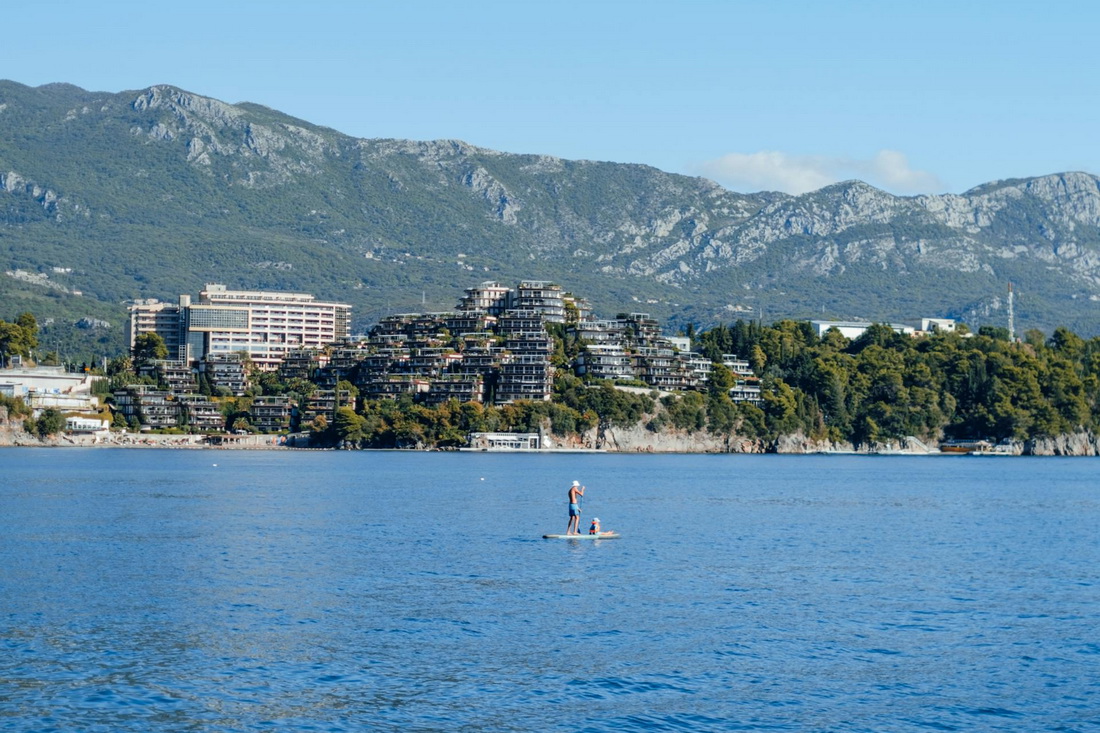
Zavala Peninsula in Budva—a narrow stretch dividing Budva and Bečići, home to beaches, hotels, and beach bars. Photo: Hatice Baran
Budva draws crowds for a reason—the water here is clear, the sun shows up most days, and the coastline stretches over 35 kilometres. But not all beaches are created equal. Here’s a look at the ones worth knowing.
Richardova Glava
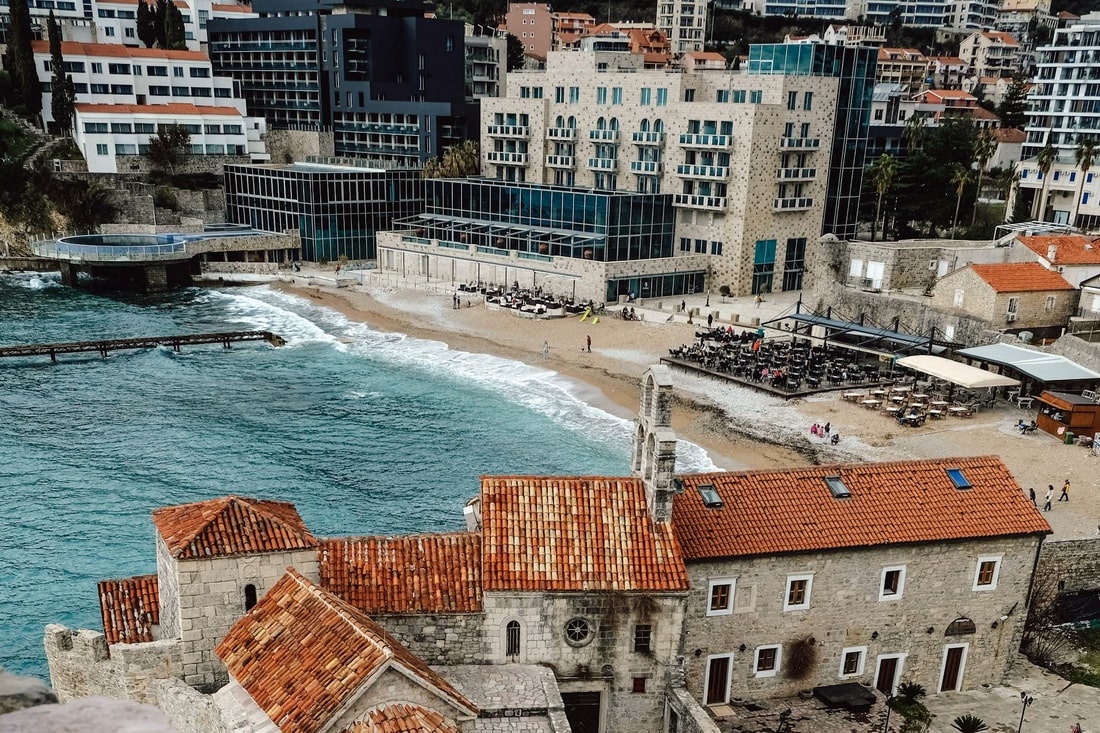
This photo was taken in late April—hence the empty beach. In summer, Richardova Glava gets packed, especially near the café. Photo: Azra Tuba Demir
Distance from Budva: In the Old Town
Beach surface: Sand and pebbles
Details: This small beach sits right below the Old Town walls and is great for postcard-worthy photos. Entry is free, but most of the space is taken up by a café with sunbeds for rent—so in summer it feels more like a private beach club than a public beach. Still, if you come early or don’t mind sitting on a towel, you can find a free spot.
How to get there: Just steps from the Old Town—no hiking required.
Slovenska Plaža
Distance from Budva: Right in town, stretching east from the port toward Bečići
Beach surface: Sand, pebbles, and concrete
Details: Budva’s longest and busiest beach. Bars, cafés, and rental kiosks line the promenade. Most sections rent sunbeds (sometimes with a spend credit at the bar); free areas exist but are usually less clean and very crowded in peak season.
How to get there: Easy on foot if you’re near the Old Town or the central promenade. From farther districts, it’s a 20–30-minute walk or a short bus or taxi ride.
Zavala (managed beach-club area, Dukley)
Distance from Budva: 2 km (east, toward Bečići)
Beach surface: Sand and small pebbles; managed sections
Details: A narrow headland between Budva and Bečići with several managed stretches (e.g., Dukley). Expect paid loungers/daybeds and on-site restaurants; free patches are limited and get busy in peak season. Music from beach bars is common by day.
How to get there: On foot along the Slovenska promenade through the pedestrian tunnel toward Bečići (about 25–35 minutes from the Old Town), or by taxi (5–10 minutes).
Mogren I & II
Mogren Beach deserves its own shoutout in this Budva travel guide — partly for the beauty, partly for the theatrics of getting there.
Distance from Budva: 1.5 km west of the Old Town
Beach surface: Sand and pebbles
Details: Two connected beaches, linked by a tunnel through the rocks. Mogren I is more popular, while Mogren II feels quieter. Both have sunbeds, showers, and cafés. Access may be restricted after storms; check the gate on arrival and go in daylight. It’s a scenic walk to get there—don’t miss the ballerina statue on the cliffside path.
How to get there: On foot along the coastal path from the Old Town.
Bečići
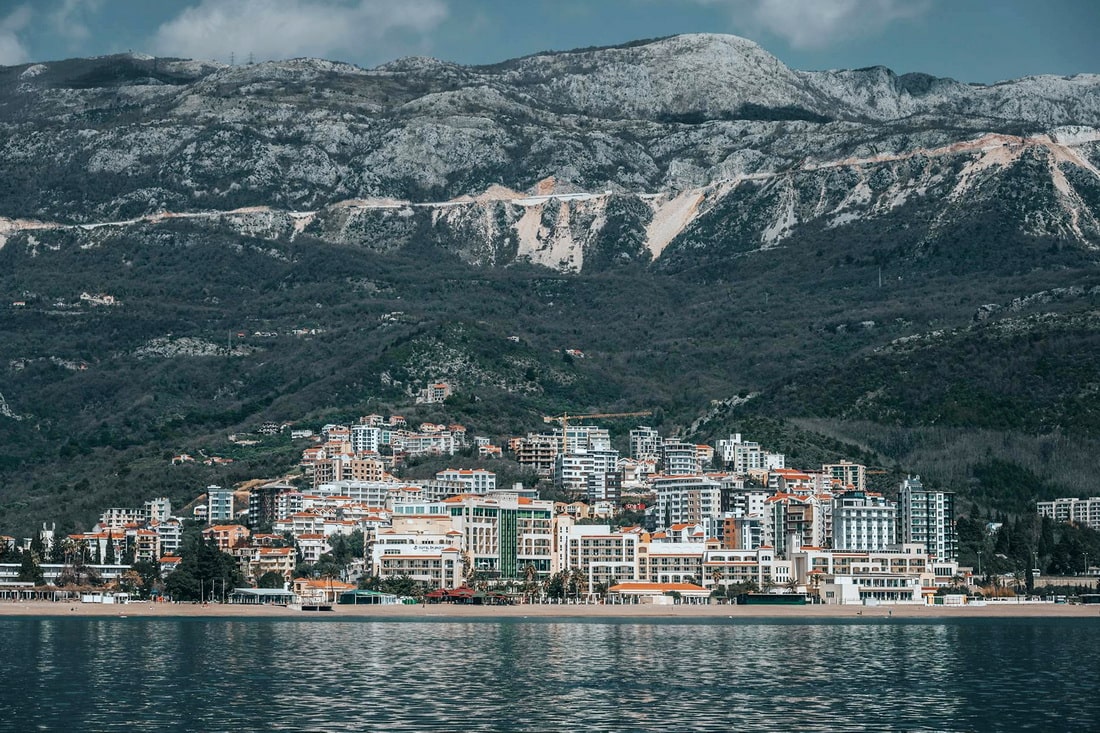
The beach at Bečići is long and open, with a scenic coastal trail connecting it to Budva. Photo: Zekai Zhu
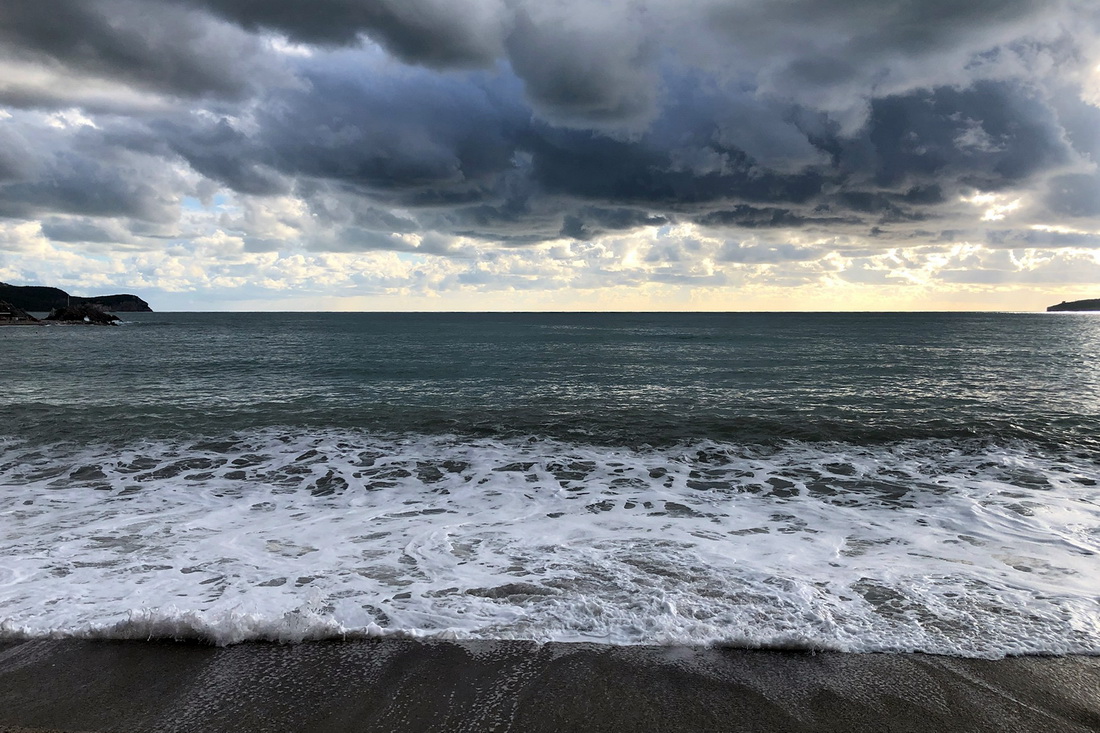
Stormy skies and a deserted Bečići beach—a rare quiet moment before summer crowds arrive. Photo: Alexey Syrkovsky
Distance from Budva: 3 km
Beach surface: Sand and pebbles
Details: A long, wide beach with plenty of space, loungers, cafés, and restaurants. Most of the shoreline is managed by large hotels, but free spots exist. When booking an apartment, check the elevation — many buildings with “sea views” are actually high up a steep hill. It looks close on the map, but the descent and climb can be tiring.
How to get there: Walkable from Budva in about 40 minutes via a scenic seaside path. Or take a local bus from Jadranski Put (every 15–20 minutes).
Rafailovići
Distance from Budva: 4 km
Beach surface: Sand and pebbles
Details: A small resort village with a family feel and a relaxed beach lined with restaurants and low-rise buildings. Shares the promenade with Bečići, so you can easily stroll between the two.
How to get there: Same route as to Bečići—on foot along the promenade or by local bus.
Jaz
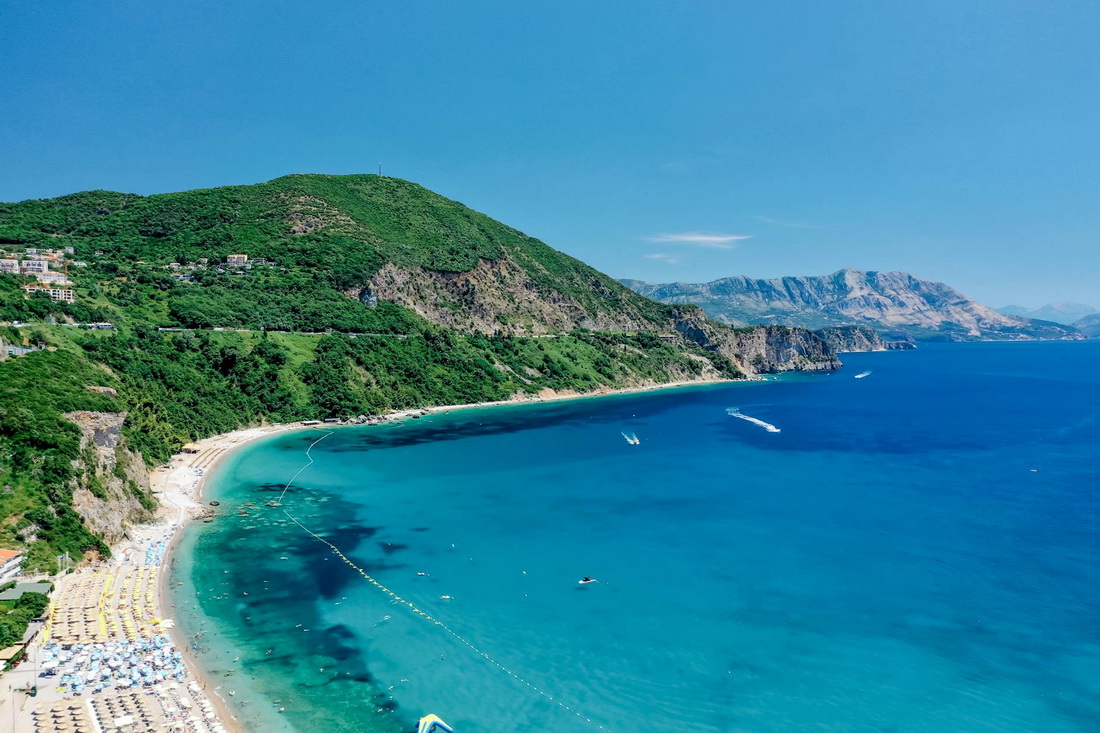
Jaz Beach is long and breezy—less crowded than Budva’s central beaches, especially outside of peak hours. Photo: Mikhail Nilov
Distance from Budva: 6 km (towards Tivat)
Beach surface: Sand and pebbles
Details: One of the widest and most open beaches near Budva. It’s less developed than Bečići or Slovenska, and tends to stay more relaxed even in high season. Facilities include sunbeds, showers, and cafés. Jaz has hosted big-name festivals in the past, but Sea Dance now moves between locations and is no longer a Budva fixture. These days the beach is mostly laid-back, with only the occasional event breaking the calm.
How to get there: Easiest by car or taxi. You can also take a regional bus (Budva–Tivat or Budva–Kotor) and ask to be dropped off at the turn to Jaz Beach. From there, it’s a 500-metre walk downhill on an unpaved roadside.
Kamenovo
Distance from Budva: 6 km
Beach surface: Sandy-pebble
Details: A scenic cove with clear water and dramatic cliffs, popular with younger crowds. There’s a beach club with loud music, cocktails, and loungers (€15–20), but you can also bring your own towel and find a free spot. Shade is limited, so come prepared. The sea gets deep quickly here, which can be great for swimming.
How to get there: On foot from Rafailovići—follow the coastal path through a short tunnel. The walk takes about 10 minutes.
Pržno
Distance from Budva: 7 km
Beach surface: Sandy-pebble
Details: A small, sheltered beach in a fishing village turned upscale resort. Sunbeds cost around €20, and space is limited in high season. While the beach is modest, the surroundings are charming: olive trees, small boats, and excellent fish restaurants with sea views (try Langust or Blanche). In the evenings, it’s peaceful and romantic.
How to get there: On foot (about 1 hour from Budva), by taxi (€8–12), or by local bus from Jadranski Put (line to Sveti Stefan).
Milocer Queen’s Beach (Kraljičina Plaža)
Distance from Budva: 8 km
Beach surface: Fine sand and small pebbles
Details: A photogenic crescent framed by pines and pale cliffs. As of summer 2025 the shoreline is open to the public again. Facilities are minimal: sunbed rentals are rare, and showers/changing cabins may be absent. Bring your own shade (umbrella or beach tent) and water. Rules may change due to the ongoing resort dispute, so check on-site signs.
How to get there: By car or taxi. The public path through Miločer Park gives easy access and views; go early for softer light.
Milocer King’s Beach (Kraljeva Plaža)
Distance from Budva: 8 km
Beach surface: Sandy
Details: The wider, sunnier neighbour in front of Villa Miločer. Public access was restored in 2025, but amenities remain patchy: don’t count on lifeguards, showers, or consistent sunbed rentals. Bring your own shade (umbrella or beach tent). Sveti Stefan island and Villa Miločer remain closed to visitors.
How to get there: By car or taxi. You also get good angles from the promenade between Pržno and Sveti Stefan.
Where to Stay in Budva — My Travel Guide Favourites
Budva has thousands of places to stay. Here’s a shortlist of ones close to the beach—from boutique hotels to basic hostels.
Old Town / Richardova Glava
Hotel Astoria–small hotel inside the Old Town walls with a private beach area and rooftop bar. Pricey for what it offers, but you pay for the location.
La Villa Boutique Hotel—modern and quiet stay just inside the Old Town walls. Stylish rooms, some with balconies. Great location, but expect cobblestones.
Slovenska Plaža area
Hotel Slovenska Plaža Standard—big seafront resort with pools and cafés. Great location, but rooms are basic and a bit tired.
Iberostar Waves Slavija—modern hotel near the eastern end of Slovenska Plaža, with a rooftop pool and some sea-facing rooms. About 10 minutes on foot to the beach, 25 minutes to the Old Town.
Garni Hotel Fineso—budget option near the main road. Around 5 minutes’ walk to Slovenska Beach. Basic, but decent value.
Bečići
Katamare Hotel—modern hotel right on Bečići Beach, with a small rooftop pool and quiet atmosphere.
Casa Al Mare Residence—quiet aparthotel by the beach with balconies, kitchenettes, and a small pool.
Hotel Kuč—small hotel uphill from the beach. Renovated, but be ready for the climb.
Hostels
Freedom Hostel Budva—social and central, just outside the Old Town. Small rooms, shared spaces, lively vibe.
The High Hostel—hilltop hostel with sea views. Clean and quiet, but a steep walk back.
All of these are within easy reach of the coast — and regularly book out in summer, so don’t wait too long if you spot something you like.
Which Beach to Choose?

Some beaches in Budva are better for kids — with shallow water, gentle waves, and room for small summer moments like this.
Travelling with kids?
Bečići or Rafailovići. Wide, sandy-pebble, with easy entry and plenty of cafés. Bečići is busier, Rafailovići cozier. Skip Kamenovo—sharp drop-off, loud music by noon.
Want iconic photos?
Richardova Glava gives you stone walls and turquoise water in one frame. Queen’s Beach looks idyllic; in summer 2025 it’s open to the public again, but rules shift with the resort dispute—check the signs.
Like walking and views?
Mogren I & II: cliffside path, ballerina statue, and two coves linked by a rock tunnel. Or take the full coastal trail Budva → Bečići → Rafailovići → Kamenovo → Pržno → Sveti Stefan. Just not at noon in July.
Looking for beach clubs?
Kamenovo. Cocktails, DJs, and a touch of chaos. You’ll either love it or flee in ten minutes.
Prefer peace and open space?
Jaz feels wide and breezy even in August. Still has sunbeds and showers, but far less squeeze.
Craving a full day with a sea-view lunch?
Pržno. Tiny beach, big seafood, and romantic paths curling towards Sveti Stefan.
Where to Watch the Sunset in and around Budva
There’s something quietly memorable about watching the sun go down in a new place—and Budva makes it easy. Between the sea, the cliffs, and the long pink skies, good spots aren’t hard to find. But if you’re up for a climb, the views get even better.
1. The Seaside in Budva
You don’t have to leave Budva to catch the colours of the day fading over the Adriatic. One of the easiest and loveliest options: just walk along the beaches west of the Citadel toward Mogren. You’ll get postcard views of the Old Town framed by palm trees, cliffs, and golden light. No hiking shoes required—just find a spot in the sand.
2. Pojata
Coordinates: 42.31828, 18.82330
Locals often call it Pojata—a nickname that stuck—but the actual name is Ribnjaci Krapina, a family-run fish restaurant tucked into the hills above Budva. It sits in the small village of Krapina, about 5–6 km from town, and feels pleasantly remote despite being so close.
To get there on foot, start at Podmaine Monastery and follow the quiet paved road uphill. You’ll pass olive groves, dry stone walls, the occasional goat, and hardly any cars. The walk takes about an hour and ends with a cold drink, a tiny waterfall, and a view that glows at sunset.
Even in summer, the breeze lifts off the hillside—bring something warm just in case.
3. Church of St. Sava
Coordinates: 42.25784, 18.90096
Perched on a hill high above Sveti Stefan, this small Orthodox church is one of the best panoramic spots on the Budva Riviera. From here, the view stretches wide—red rooftops below, the famous island in the bay, and a coastline that fades into the blue. It’s especially stunning at sunset, when the sea turns silver and the hills catch the last light.
The church itself is modest—white walls, red roof, no entrance fee — but it’s popular for weddings thanks to the light and the setting. There are no facilities on site, just peace, sky, and a few benches if you’re lucky.
How to get there: the easiest way is by car or taxi. There’s a small parking area near the top, and from there it’s a short walk on a gravel road. Prefer to hike? Take a bus from Budva to Sveti Stefan (20–30 minutes), then follow the marked trail uphill. It’s a steady climb of about 200 metres, partly on rocky ground, but not difficult — and the view at the top makes it more than worth the effort.
4. Mount Čelobrdo
Coordinates: 42.26438, 18.90011
Čelobrdo is one of those viewpoints that feels like a secret—until you get to the top and realise you’re not the only one who thought of it. From here, the coastline opens wide: Sveti Stefan island just below, the hills behind Budva fading into dusk, and the sea stretching all the way to the horizon.
The most common route starts from Sveti Stefan beach and climbs steadily uphill, gaining around 200–250 metres of elevation. It’s about 4 km one way, depending on where you start, and takes 1.5 to 2 hours each way with breaks. Some sections are paved or gravel; others follow an old stone path through pine trees, with goats or lizards occasionally crossing your way.
In summer, bring water, sun protection, and proper shoes—the trail is mostly easy but can be rocky in parts. There are no signs, cafés, or benches at the top, just space, quiet, and a view that earns its reputation.
5. Kosmač Fort
Coordinates: 42.30134, 18.90048
High above the village of Brajići, Kosmač is one of those places where silence says more than any plaque. Built by the Austro-Hungarians in the mid-1800s, it once guarded the border of their empire. Today it’s a crumbling shell—roofless, abandoned, and slowly being reclaimed by wind and lichen.
The outer walls still stand, but inside it’s part ruin, part bat cave. Expect missing floors, fallen stones, and the occasional rustle from a corner that’s definitely not empty. Step lightly—the bats were here first.
What hasn’t collapsed is the view: a vast sweep of valleys, ridges, and the sea far below. In the evening light, it feels almost too cinematic.
How to get there: take a bus from Budva to Brajići (about 25 minutes, €1.5–2). From the village, it’s a 15-minute walk uphill through pine trees and past sleepy houses. The last part is unpaved, but the path is clear. If you prefer a full hike, you can walk all the way from Budva—about 12 km one way— though it’s a long, exposed climb in the sun.
Budva Travel Guide: What You’ll Really Spend
Budva isn’t the bargain it once was—prices have climbed for groceries, lodging, and transport. But it’s still more affordable than most Mediterranean beach towns. Smart planning keeps it budget-friendly.
Accommodation
Hotels:
Typical 3–4★ stays cost €60 to €130 per night.
Closer to Bečići or along the seafront, expect €150 to €200.
Designer hotels near Sveti Stefan start around €300 and can go well over €400 in peak season.
Apartments & guesthouses:
In summer, prices start around €40 to €50 per night.
In shoulder season (June or September), you can often find places for €30 to €40 per night.
Longer stays in winter or November may drop to €350 to €500 per month.
Monthly rent:
A one-bedroom apartment typically costs €350 to €600 per month, plus utilities. Electricity, water, and internet usually add another €80 to €120, depending on usage and the building.
Tip: Book early if you’re coming in summer. Outside peak season, it’s usually easy to find a place a week or two in advance.
Where to book: For hotels and apartments in Budva, I usually start with Trip.com and Booking.com—both have a wide selection, clear filters, and helpful reviews. For hostels and budget beds, Hostelworld is also worth checking. If you’re coming in July or August, book early: the best places near the beach go fast.
Tourist tax (Budva)
Adults €1 per night; ages 12–18 €0.50; under 12 free. You need to register within 24 hours of arriving. Hotels and official apartments take care of it; if you’re in a private flat, you’ll have to stop by the tourist office, where they also collect the fee.
Why this matters: if you’re not registered, border officers may ask about it when you leave. Always double-check with your host that it’s been done.
Food Prices (Summer 2025)
Groceries are no longer super cheap, but still reasonable compared to EU standards:
- Milk (1 L): €1.00–1.30
- Eggs (10–12): €2.50–3.10
- Chicken breast (1 kg): €6–8
- Beef (1 kg): €5–12
- Tomatoes (1 kg): €1.50–2.50
- Potatoes (1 kg): ~€1
- Apples (1 kg): €1–1.30
- Local cheese (1 kg): €7–9
- Wine (750 ml): €4–10
- Pastry or bun: ~€1.50
- Mineral water (1.5 L): ~€0.70
A grocery run for two — say, enough for a few days — might cost €25–35. Over a full month, your food budget could land anywhere between €400 and €700, depending on how often you cook at home or go out to eat.
Transport
Bus: Budva → Kotor or Tivat (~20–23 km): €3–4 one way, €1 extra per piece of checked luggage.
Taxi: Airport Tivat → Budva (~21 km): €45–50 per car; Budva → Bečići (~3 km): ~€7
Sending a Postcard
Postage for postcards/light letters is usually around €1 within Europe and slightly more overseas; exact tariffs depend on service and destination—confirm at the counter.
Post offices often mean queues and brisk clerks—but postcards get delivered.
Quick Breakdown: What You’ll Likely Spend in Budva (2025)
€60–130
€30–50
€350–600 + utilities
€400–700
€3–4
€7–10
What to Eat in Budva — A Local Foodie’s Travel Guide
Budva may not be a culinary capital, but it feeds you well—especially if you like grilled meat, cheese, and hearty portions. The food scene blends Mediterranean breeze with Balkan appetite: fish and olive oil on one table, sausage and sour cream on the next. And while seafood is everywhere, meat is usually the safer (and more satisfying) choice.
You’ll find restaurants and konobas (traditional taverns) all over town. Those near the waterfront charge more — often €15–20 for a main versus €8–12 just a few blocks inland. Portions are generous. Vegetarian dishes exist, but menus tend to be protein-heavy.
The Meat of the Matter
Montenegrin cuisine leans heavily on pork, beef, and lamb. Most dishes are grilled or fried, with raw vegetables on the side (tomato, cucumber, onion). Chicken appears but rarely stars. Spices are mild, sauces are few, and the focus is on filling you up.
Ćevapi
Montenegro’s answer to the burger: tiny grilled sausages made from spiced minced meat. Served with fries and raw onion. Filling, reliable, and usually €9–12.
Pljeskavica
A juicy meat patty—often spiced, sometimes stuffed with cheese or bacon. Like a Balkan burger without the bun. Prices hover around €7–10.
Njeguški steak
The local star: pork or veal steak stuffed with pršut (dry-cured ham) and kajmak (creamy cheese), then grilled. It’s indulgent, rich, and often enough for two. Costs €18–25, depending on location.
Seafood — With Caveats
The Adriatic is full of fish, but not every kitchen knows what to do with it. Many tourist spots serve grilled white fish, squid, or seafood risotto—but quality varies. Expect to pay €15–25 for a seafood main. Want it fresh and done right? I’ll tell you later where locals shop for fish or have it grilled on the spot.
Local Drinks
Wine
Montenegro’s main varietals are Vranac (a bold, dry red with dark berry notes) and Krstač (a crisp, floral white). Both grow around Lake Skadar and Podgorica.
Restaurant bottles go for €10–15 depending on the label and location. Supermarkets offer the same wines for €5–8. Good producers include Plantaže—their Vranac Pro Corde is a richer red, while Krstač pairs well with summer heat.
Beer & soft drinks
A glass of local beer usually costs €2–3. Homemade lemonade (domaći limunada) is simply water and lemon—sometimes with sugar or honey, but rarely too sweet.
Coffee
Local coffee means Turkish-style: strong, unfiltered, and loved. In cafés, you’ll more often get espresso unless you ask for domaca kafa. Americano is usually weak.
Tea
Locals mostly drink herbal teas—mint, linden, and chamomile. Ask for black tea and you’ll likely get a lonely Lipton bag.
Desserts — If You Have Room
Desserts don’t steal the spotlight in Budva. You’ll find pancakes (palacinke) with jam or chocolate, baklava in bakeries, and standard ice cream. Many locals simply linger over coffee instead.
Where to Buy Fish, Kaymak, and Fruit in Budva
Budva has plenty of grocery stores and two main markets. You’ll find fruit and vegetables at both, with similar selection, but supermarkets often charge less. Market vendors tend to claim their goods are local, though much of it comes from elsewhere.
Hypermarkets and supermarkets
HDL: Budva’s only hypermarket, about 1 km from the sea (on Žrtava Fašizma Avenue). It has two floors of food, household goods, and random surprises like flip-flops or frying pans. Closed on Sundays.
Supermarkets: Chains like Mega Market, Idea, Franca, and Voli are everywhere—you’re never far from one. They’re perfect for daily shopping; some even have fresh meat and cheese counters. Most stay open until 22:00.
Markets
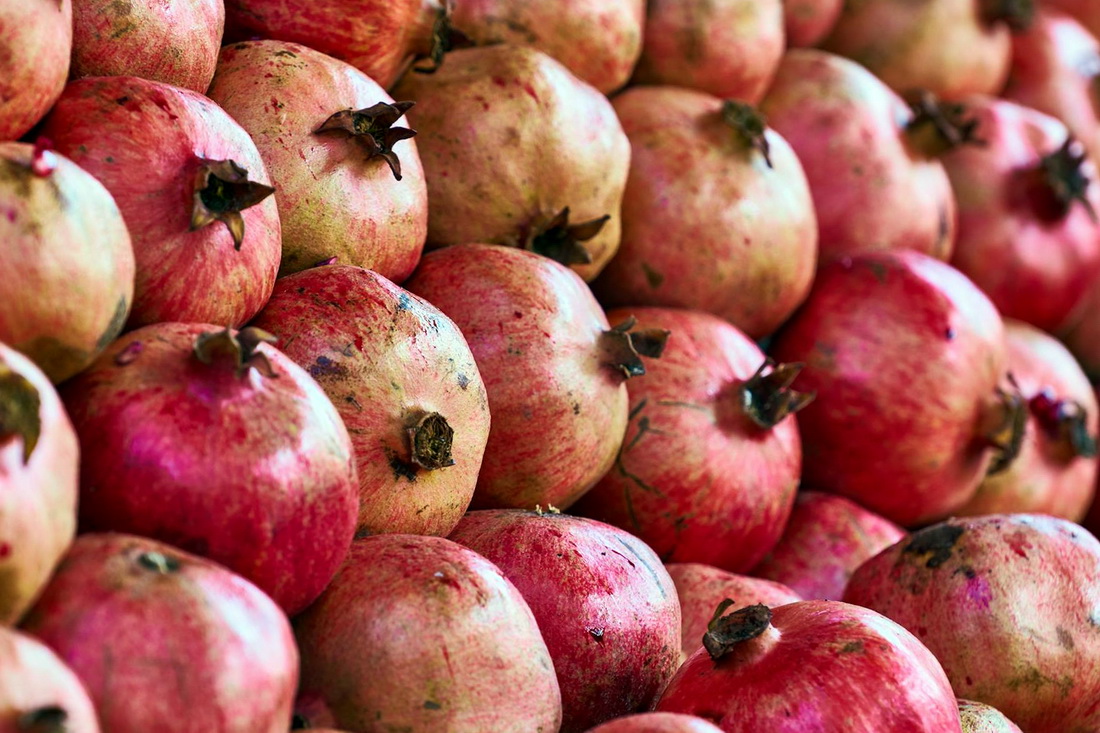
Local pomegranates may look a little rough—some with green patches or split skin—but they taste incredible when in season.
Zelena Pijaca: Near Slovenska Plaža, on Mediteranska Street. You’ll find meat, cheese, kaymak, olives, oil, and plenty of fruit—though not all of it’s local. Come for the pomegranates in autumn (late September to November). The market closes early, and prices lean touristy.
Tržnica: A smaller, simpler option near Hotel Kadmo (Filipa Kovačevića Street). It only sells fruit and veg—with fewer crowds, slightly better prices, and a more local feel. Also wraps up early.
Fresh Fish
Tiny Fish Market by the Port: Open in summer, and worth the wait. Boats bring in fresh catch after 16:00 — walk by in the evening and see what’s landed. It’s low-key and feels like the “real Budva.”
Fish Counter at Zelena Pijaca: Tucked near Mega Market and Pekara Bakery (no big signs, just follow the smell). You’ll usually see about 8–10 types of fish and seafood: dorado, plaice, seabass, squid, shrimp. Not all of it’s local—some is farmed—but they’ll grill it for you while you wait. Takes about 30 minutes, and you’ll walk away with a warm lunch in a paper box.
Food Shopping in Budva: What to Know in 2025
- Best fish prices—at the tiny fish market near the port after 16:00 (summer only).
- Quickest grocery run—Mega Market and Voli have everything you need.
- Cheapest fruit—supermarkets beat markets by 25–50%.
- Tržnica feels more local and has slightly better prices than Zelena Pijaca.
- Bring cash for markets—not all stalls take cards.
When to Visit Budva
Budva’s peak season runs from June to August—sunny days, hot nights, warm sea, and plenty of people. Expect crowded beaches, higher prices, and restaurants that fill up fast. If you like sun and buzz, this is Budva at full throttle.
For something calmer, aim for April, May, or September. In spring, the town smells of pine and wildflowers, and temperatures hover between 18–25°C. It’s too early to swim—the sea stays cool—but perfect for hikes, sea views, and sun without the burn.
September is perhaps the best of both worlds: the sea’s still warm (around 25°C at first, dropping to 21–22°C by month’s end), the crowds start thinning, and the air is softer. Evenings may need a jacket, but you can still swim, hike, or just sit with a book by the shore.
Personally, I love April and May. It’s still cold where I live, but in Budva, everything’s blooming, the sea sparkles, and you can walk for hours without bumping into tour groups.
January and February? Not great. Rainy days stretch on, storms roll in from the sea, and homes are heated by the same humming wall units that buzz in summer and try their best in winter. Most cafés and restaurants close for the season, and the town feels like it’s gone into hibernation.
Weather in Budva by Season
- March: 13–17 °C by day, 8–10 °C at night. Sea ~14 °C. First hints of spring, with some rain.
- April–May: 16–25 °C by day, 10–15 °C at night. Sea 15–20 °C. Flowers, hikes, and cool, clear air.
- June–August: 27–32 °C by day, 18–22 °C at night. Sea 23–26 °C (cooler in June, warmer in July–August). Hot, festive, and full.
- September: 22–28 °C at the start, 18–22 °C by the end. Sea about 25 °C at first, slipping to 21 °C by month’s end. Still swimmable.
- October: 18–23 °C. Sea ~20 °C. Quieter, greener, with some rain.
- November–December: 12–17 °C. Sea 16–18 °C. Cooler, cloudier, with occasional storms.
- January–February: 8–13 °C. Sea ~14 °C. Rain, wind, and a town that feels like it’s gone to sleep.
How to get to Budva
You can fly into either Tivat or Podgorica, but don’t expect a direct bus to Budva from the airport.
Tivat Airport → Budva (≈21 km)
There’s no dedicated airport shuttle to Budva. A taxi is the fastest; the bus is the budget choice. Sidewalks around the airport are patchy, so rolling a suitcase at night isn’t fun.
Option 1 — Bus via Tivat Bus Station
Walk 1.4–1.6 km (15–20 min) to the station or take a short taxi hop. Buses to Budva run about every 30–60 min from early morning until late evening (seasonal). Tickets €3–4; travel time 25–40 min depending on traffic. Some carriers charge ~€1 per checked suitcase. In high season buses fill up — allow extra time.
Option 2 — Taxi door to door
Around €40–50 in summer, 25–40 min depending on traffic. Agree the fare in advance or ask for the meter; cash is still common. No Uber or Bolt in Montenegro — use a licensed taxi or a pre-booked transfer.
Option 3 — Hail on the main road (Jadranska magistrala)
About 200–400 m from the terminal you can try flagging an intercity bus. It’s hit-or-miss: buses may be full and won’t always stop, and there’s no shelter. Not great at night or with heavy luggage.
Late-night tip: after ~21:00 departures thin out. If you land late, take a taxi.
Podgorica Airport → Budva (≈65 km)
There’s no direct bus from the airport to Budva. First get to Podgorica’s Central Bus Station (by airport bus, short train hop, or taxi), then continue by intercity bus. A taxi all the way is the simplest but more expensive option.
Option 1 — Bus via Podgorica Central Bus Station
An airport bus runs to the Central Bus Station, operated by BTC Zeta, MS Tours, and Zejdin. The ride takes 15–30 minutes depending on route and stops; tickets are €1.5–3. Frequency isn’t high, so check timings when you land.
From the station, buses to Budva run roughly every 30–90 minutes throughout the day. Expect €5–8 and 1 h 25–1 h 45 depending on traffic. Some operators charge about €1 per checked suitcase.
Podgorica Bus Station also requires a €1 platform ticket (“peron karta”) if your ticket wasn’t issued at the station. The station can be busy and a bit chaotic in summer, so allow a few extra minutes to find your bay.
Option 2 — Short train + bus
Walk 10–15 minutes (≈1–1.5 km) from the terminal to the small Aerodrom halt. Trains to Podgorica take about 7 minutes and cost €1–2, running about every three hours. The train and bus stations are next to each other, so you can cross over and continue to Budva by bus (same prices/times as above). Handy if a train is due; otherwise the airport bus or a taxi is quicker.
Option 3 — Taxi all the way
A taxi from the airport to Budva costs about €45–60 and takes 70–90 minutes depending on traffic. Agree the fare in advance or ask for the meter; cash is still common. There’s no Uber or Bolt in Montenegro, so use a licensed taxi or a pre-booked transfer.
Late-night tip: intercity departures thin out in the evening. If you land late, plan for a taxi or a booked transfer.
Dubrovnik → Budva (≈100–110 km by road)
There’s no direct bus from the airport to Budva. First get to Dubrovnik Main Bus Station in Gruž (the airport shuttle costs €10 and takes about 30–45 minutes), then continue by intercity bus.
Buses to Budva run a few times daily; the ride usually takes 2.5–3.5 hours depending on the border, and tickets are roughly €26–35. Most operators accept mobile tickets, but some still ask you to exchange your confirmation for a printed ticket at the station—arrive a bit early and keep €1–2 for possible station fees.
Summer queues at the Karasovići/Debeli Brijeg crossing can add serious time; delays from 15 minutes up to 1–3 hours do happen on busy days, so build a buffer if you have connections.
If you prefer to skip the road, there’s also a seasonal ferry Dubrovnik–Budva (about 2 hours; foot passengers only)—check the schedule before you go.
Getting Around Budva
Long-distance coaches arrive at the Budva Main Bus Station, located about 700 m inland, which typically takes 10–15 minutes on foot to reach beaches or the Old Town. From there, a taxi ride to most central hotels costs about €4–5 (approx. €2 flag + €1/km).
Buses on the Sveti Stefan – Petrovac line run through Budva regularly during the day. Tickets cost around €1.5–3, and they serve multiple stops along the coast, making this a convenient option even without visiting the bus station.
Public transport in Montenegro works, but with quirks. Many travellers note that departure times vary, and buses may arrive late or skip less busy stops. Vehicles often look dated, get hot inside, and can be overcrowded. Many find this acceptable for short trips—but not for tight schedules.
One more quirk worth knowing: at some Montenegrin bus stations, you’ll pay a small ‘station/platform’ fee (Budva has charged around €2 in recent seasons), and some operators add a baggage fee of about €1–2 per checked piece. Carry a couple of euro coins just in case.
Bike and scooter rentals are available in Budva, offering a fun way to explore. However, the town lacks dedicated lanes, and pavements can be uneven. The promenade is rideable, but it’s busy in summer — use caution, especially near crowds.
Is Budva safe?
Yes—Budva is generally safe, even for solo travellers. But like any busy seaside town, it comes with a few things worth knowing.
In Town and Around People
Pickpockets sometimes operate in crowded areas like markets, buses, or nightlife zones. Keep an eye on your bag and avoid leaving phones or wallets on café tables.
Alcohol is part of local hospitality—especially rakija, a strong fruit brandy. The bottled stuff is around 40%, but homemade versions can reach 60% or more. It’s fine to try a glass, but don’t feel pressured. Saying no is perfectly acceptable.
Social encounters with locals are usually warm and friendly. Still, be alert if someone insists on hanging around or tries to guide you into a shop or restaurant—this can occasionally end in an unwanted bill or sales pitch.
Smoking is common—both outdoors and in some indoor spaces. If you’re sensitive to smoke, it can be hard to avoid.
On the Road
Roads in Montenegro can be narrow and winding, especially outside Budva. Drivers often overtake on curves, ignore speed limits, and it can feel chaotic if you’re not used to it. The frequent beeping isn’t aggression: it’s just how locals greet, thank, or nudge.
In Nature
Oleander, common in gardens and parks, looks lovely but is toxic—best not to touch it, and make sure children don’t either.
Snakes, spiders, and scorpions live in Montenegro’s hills and dry grasslands, but they’re rarely seen in busy tourist areas. If you’re hiking off-path, wear shoes and stay aware.
Ticks are active from spring to early autumn, especially in wooded or grassy areas. They’re tiny and can carry diseases, so check your skin after hikes.
Do People in Budva Speak English?
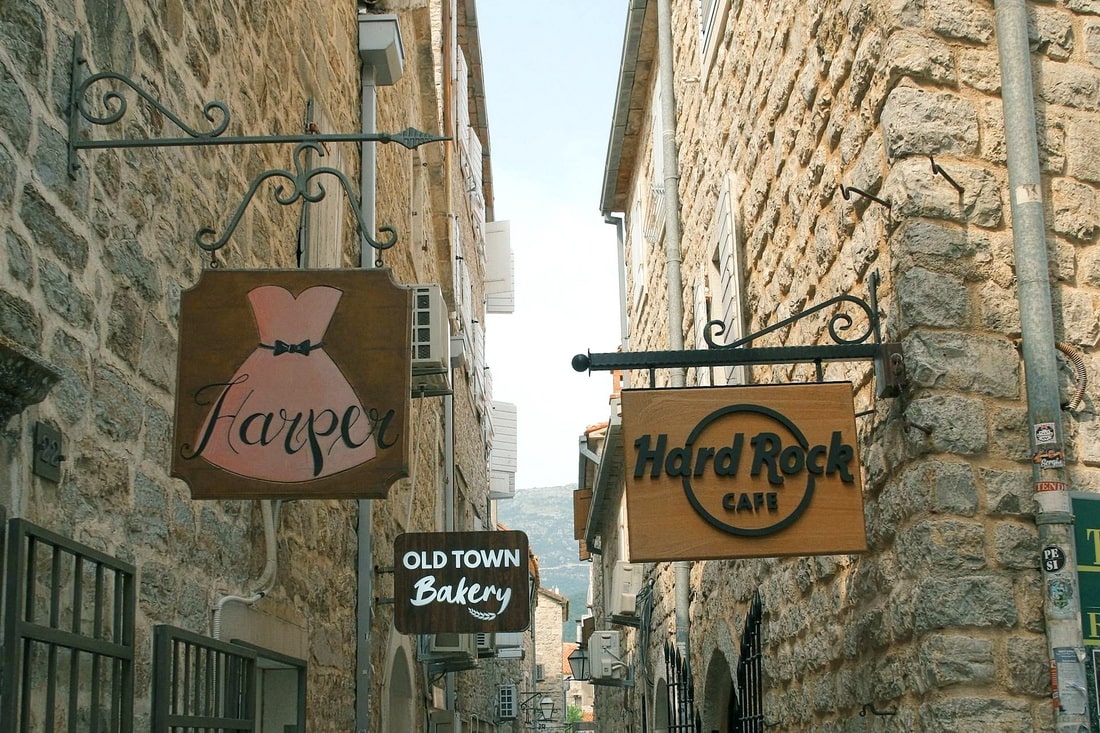
Even without a phrasebook, you’ll manage to find food, the market, and the nearest toilet in Montenegro.
You won’t have much trouble. Budva is a popular resort, and most people working in tourism — waiters, shop staff, hotel receptionists—speak at least some English. Younger locals are usually comfortable switching languages, and even older ones often understand basic phrases.
Restaurant menus are often translated into English, Russian, and sometimes Italian, so ordering is easy even if you don’t speak the language.
If you head into the countryside, though, English becomes less common—especially among older residents. Still, with a few gestures and a friendly tone, you’ll usually get your message across.
Marking Your Spot in Budva
Budva isn’t trying to be perfect—and that’s half its charm. One moment you’re dodging beach balls and techno remixes, the next you’re sitting in a stone alley with grilled squid and a view of the sunset. You might come for the sea, but you’ll stay for the contradictions.
Where you stay matters here. A hilltop apartment means quiet mornings and long climbs. A room near Slovenska Plaža puts you in the middle of the action—whether you like it or not. Old Town hotels give you charm and cobblestones, plus the echo of late-night concerts drifting in through the shutters.
I’ve tried to show you both Budvas: the postcard and the patchy, the ancient and the overbuilt, the Adriatic glow and the traffic jam just behind it.
Because this town doesn’t fit into a single picture—and that’s exactly why it sticks in your memory.
Wherever you end up, I hope Budva gives you something to carry home: a salt line on your skin, a story from a beach you didn’t plan to find, or just the feeling that summer, for a little while, was yours.
Thanks for reading this Budva travel guide—and if you’re packing sunscreen while scrolling, I’d say you’re on the right track.
